|
Me Sahyadri |
|
February 2018 |
|
Volume 5, number 3, # 57 |
|
Mysteries of Maval Caves – Shilatane Cave |
Please use minimum 1280 pixel horizontal screen resolution for viewing. Please be patient while all the images in webpage are loaded. Please do not use the images for any commercial use without permission. Text in Marathi and English is not exact translation. Please give sufficient time to allow the photographs to load. Special thanks to those who helped me during the compilation and for the help and guidance during the activity. |
|
|
|
|
देशाची आर्थिक प्रगती व्हावी असे सर्व नागरिकांना वाटणे सहाजिक आहे. अर्थकारणामुळे मिळणारा रोजगार, समृद्धी यासाठी सर्वांनाच आर्थिक प्रगती हवी हवीशी वाटते. आर्थिक प्रगती होताना, त्याचा दिर्घकाळात समाजावर, निसर्गावर, वातावरणावर दुष्परिणाम होणार नाही याची काळजी घेणे महत्वाचे आहे. मनुष्याच्या भावी पिढ्यांना पाणी, शुद्ध हवा, योग्य वातावरण मिळत रहावे अशी भावना मनात रुजणे महत्वाचे आहे. वाढत्या आर्थिक प्रगतीमुळे नैसर्गिक संपदेवर ताण येतो. प्रगतीसाठी प्रदुषण होते. जंगले, माळराने, व इतर अधिवास नष्ट होतात. वसुंधरेवर रहाणाऱ्या इतर जीवांचा मात्र मनुष्य फारसा विचार करत नाही. आर्थिक प्रगती करताना, मनुष्य निसर्गाची हानी करत आहे. मुळताच माणसाला निसर्गाचे महत्व समजणे हे सध्याच्या आपल्या प्रगत जीवनशैली मुळे अवघड झाले आहे. आर्थिक प्रगती, समाजाची प्रगती व निसर्ग संपदेची निगा, यांचा समतोल राखणे काळाची गरज आहे.
सह्याद्री (पश्चिम घाट) हा एक नैसर्गिक संपदेचा, वैविध्यतेचा, भौगोलिक व ऐतिहासिक ठेवा आहे. वाढत्या मानवी अतिक्रमणाचा, सह्याद्रीच्या विविध घटकांवर होणारा दुष्परिणाम भविष्यात आपल्यालाच धोका निर्माण करेल, यात शंका नाही. शुद्ध पाणी, हवा व उर्जा, भावी पिढीला मिळण्यासाठी, नंद्यांचे उगम असलेला सह्याद्री व त्याभागातील जंगले टिकवणे महत्वाचे आहे. सह्याद्रीच्या महत्वाच्या घटकांचे महत्व छायाचित्रांद्वारे प्रकट करण्याचा मी येथे प्रयत्न केला आहे. येथील पक्षी, प्राणी, वनस्पती, अधिवास, किल्ले व लेणी अशा विविध विषयांबद्दल आपण समजुन घेऊ.
|
|
As the economic development has taken the center stage, the balance between the environmental sustenance and socio economic development will be under the scanner. As most experts with balanced views have proclaimed, Indian wildlife and ecological system sustenance will be under threat, unless precautions are taken with the help of appropriate research and long term national interests. As we encounter the economic development, many habitats which indirectly or directly help sustainable development will be damaged. The awareness to gauge the success by sustainable development and not by year to year growth is a distant dream any environmentalist will assume in current scenario.
Western ghats, or Sahyadri as we all call it as, is a treasure trove of spectacular landscapes, biodiversity, flora, fauna, some amazing geological wonders and man made monuments. With the increasing pressure from human encroachment, all these elements are under stress and in turn are under depletion. Western ghats should be left untouched by human beings, to protect their future generations from getting short of resources, such as water, energy and clean air. The important elements of western ghats, which need protection are highlighted in the new version of Photo journal, Me Sahyadri Magazine.
|
|
|
| |
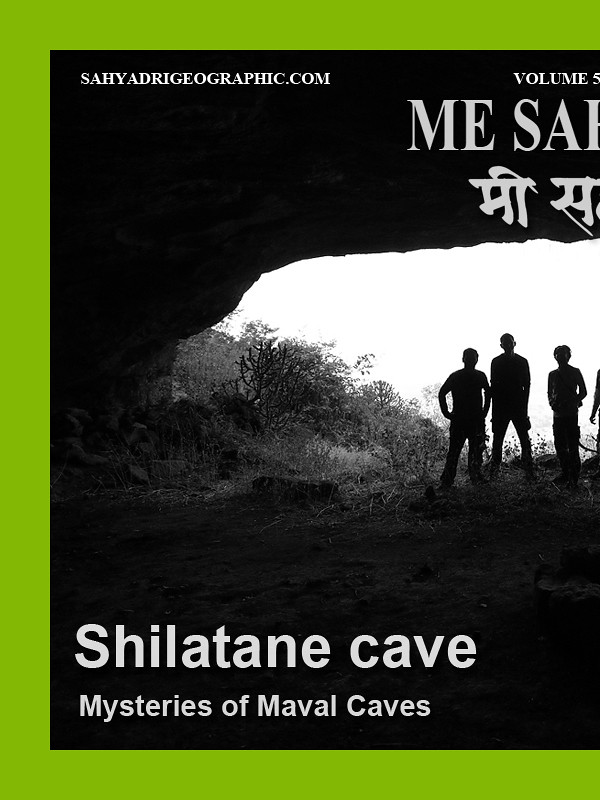 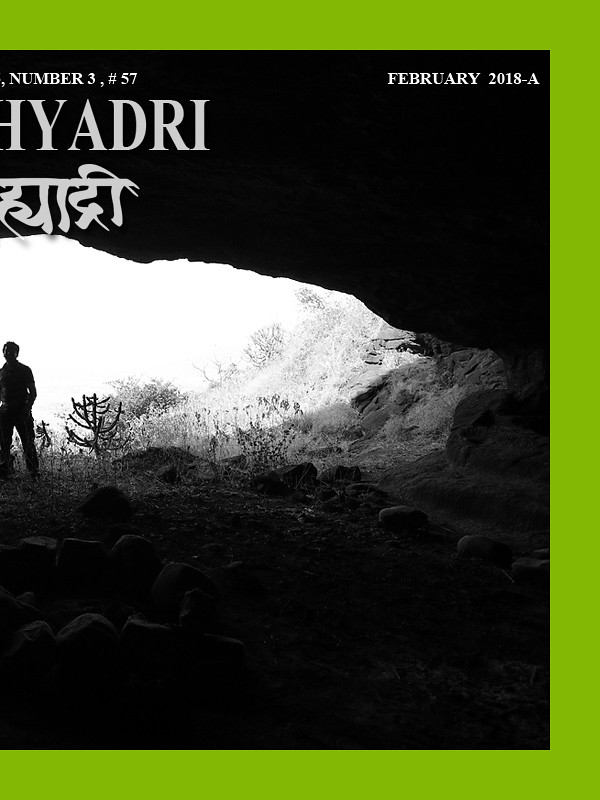
|
| |
| Me Sahyadri – February 2018 - A
|
| |
|
|
मावळ लेणी मोहेमेचा सारांश :
मावळातील भाजे, बेडसे आणि कार्ले लेणी अप्रतिम आहेत. त्यामुळे या भागातील इतर लहान लेण्यांकडे फारसे कोणी फिरकत नाही. आम्ही चार समविचारी मित्रांनी मात्र या हरवलेल्या लेण्यांची शोधाशोध करण्याचे ठरवले. साईप्रकाश बेलसरे, निनाद बारटक्के, अमेय जोशी आणि विवेक काळे असा संघ तयार झाला. एकोणीसाव्या शतकात जेम्स बर्जेस आणि जेम्स फर्ग्युसन या दोन इंग्रज विद्वानांनी भारतातील लेणी धुंडाळली. त्यांनी १८८० साली "केव्ह टेम्पल्स ऑफ इंडिया" या पुस्तकाचे प्रकाशन केले. या पुस्तकात मावळातील लहान लेण्यांचा फारसा तपशिल नसला तरी, या मावळातील इतर लहान लेण्यांबद्दल ५-६ वाक्यांमध्ये आम्हाला त्रोटक का होईना माहिती मिळाली. त्यांनी उल्लेख केलेली, काही ठिकाण सापडली, तर काही ठिकाण काहीही केल्या सापडेनात. कदाचित न सापडलेली ठिकाण नष्ट झाली असावीत. पण मोहिमे दरम्यान नविन, ज्या ठिकाणांचा पुस्तकात उल्लेख नव्हता, पण ग्रामीण भागातल्या स्थानिकांना माहिती होती अशी ठिकाण सापडली.
जेम्स बर्जेस आणि जेम्स फर्ग्युसन या दोन इंग्रज विद्वानांनी लिहिलेल्या प्रत्येक शब्दाचा धागा म्हणुन वापर करायचे ठरले. कामांचे वाटप झाले.
शोध मोहिमेत लागणाऱ्या खाऊची सोय करणे, विषय आणि ठिकाणाचा आधी अभ्यास करणे, प्रवासाची सोय करणे, गावकऱ्यांकडे लेण्यांबद्दल चौकश्या करणे, मोहिमे दरम्यान गचपणातुन वाट शोधणे, लेण्याच्या अवशेषांची मोजमाप घेऊन त्याची चित्रे/नकाशे काढणे, छायाचित्रे काढणे, जि. पि. एस. यंत्रावर वाटेबद्दल माहिती नोंदवणे, लेण्यात लहान बारकावे शोधणे, लेण्यांचे विश्लेषण करणे, नोंदी करणे, अशी वेगवेगळ्या प्रकारची काम वाटुन घेण्यात आली.
प्रत्येक ठिकाणी जाताना, घरचा अभ्यास करावा लागला. जुनी पुस्तके, नकाशे धुंडाळले गेले. गावातल्या मित्रांची मदत झाली. गावागावात चौकश्या केल्या. गडद, लेणे, गुहा, कपार, भोगदा, विहार, पांडवांनी एका रात्री बनवलेली गुहा असे अनेक शब्द वापरुन चौकश्या झाल्या. बहुतेक वेळा असे काही नाही इथे ! तुम्ही कुठुन आलात ? असे उत्तर मिळाले. लेणे आहे का इथे कुठे असा प्रश्न विचारला तर आम्हाला बहुतेकांनी कार्ले/बेडसे/भाजे लेण्यांचा पत्ता दिला. पण बकऱ्या, गाई घेऊन डोंगरात फिरणारे गुराखी मात्र दरवेळेला मदतीला धाउन आले. वाटांचे आणि दिशांचे अंदाज मिळाले. जुजबी माहिती घेऊन ठिकाण शोधणे या प्रकाराचा चांगला सराव झाला. कधी काटेरी करवंदींच्या खालुन खुप सरपटाव लागल तर कधी घसाऱ्यावर हात टेकावे लागले.
लेण्यांमध्ये मोठे कोळी (स्पायडर), कातळ पाली, वटवाघळ, मधमाश्या, पाकोळ्या, घुबडं भेटले. आमच्या मुळे त्यांना उगाच त्रास झाला, असा अपराधीपणा वाटला. प्रत्येक शोधमोहिमेला यश आलेच असे नाही. काही ठिकाण सापडली नाहीत. तर काही ठिकाण आमच्याच मनाचे खेळ आहेत असे लक्षात आले. बहुतांश ठिकाणी कोणत्या ना कोणत्या प्रकारची जोखिम होती. वटवाघळ, लेण्यातील धुळ, काळोख, मधमाश्या, काटेरी वनस्पती, घसारा, गुहेतील ऑक्सिजन चा अभावआणि इतर न दिसणारे धोके यावर मात झाली. मोहिमेसाठी, विजेऱ्या, जि. पि. एस., मोजपट्या, दोऱ्या, लेजर यंत्र, नकाशे, गुगल मॅप, जाळीच्या टोप्या या सर्व जंत्रीचा उपयोग झाला. एकूण मिळुन २० नविन अपरिचित ठिकाण/वास्तु पहायला मिळाल्या, मावळाचा भुगोल जरा अजुन नीट लक्षात आला. नविन प्रश्न पडले आणि नविन कोडी सोडवयाला मिळाली. तर्क वितर्क झाले.
|
|
About the Maval Cave exploration :
The main caves in Maval region are so significant that other small hermit caves are often overlooked. We as a team of four like minded friends, decided to explore the Maval region for these small hermit caves. We explored and found few beautiful places. The very concept of creating a hermit cave somewhere high up in the hills is fascinating. These places often are full of tranquility and nothing else. With very little architectural evidences and clues, the academicians have obviously ignored these places. It was James Fergusson and James Burgess, during their exhaustive study of “Cave temples of India, 1880” mentioned few of these hermits in Maval region of Pune district. With the little clues and exhaustive investigation, team of four members, Saprakash Belsare, Amey Joshi, Ninad Bartakke and Vivek Kale started the exploration. The journey to locate, trek and analyse these hermit caves itself was fascinating. We met many villagers who were unaware of these places, but also met few shephards who were precisely aware of the hermits and gave us tentaive guidance.
There is a very brief mention about the misceleneous caves of Maval by James fergusson and James Burgess in their work. Based on available information we decided to search these caves and monuments. The activities were planned. The food, travel , track exploration in difficult and routes full of foliage, enquiring the villagers about the caves, taking measurements and drawing skecthes and maps, photography, GPS data collection, making notes and analysing the information, observing the minor details of the caves etc activites were distributed amongst the team members. We met many bats, owls, geckos, lizards, large spiders, martins, honeybees during the treks. Often we felt sad that we disturbed them to see the caves. Most of these places are hazardous due to pitch darkness, bats, dust, thorny plants, honeybees, low oxygen level in caves and rock patches etc. Not all the attemps were successful. Sometimes we could not find the intended places and sometimes we realised that the cave was just our imagination and did not exist. Nevertheless we saw about 20 new strange caves/monuments during the exploration. The high intensity torches, GPS tool, measuring tapes and measuring laser tool, Honeybee protection caps, maps, google maps, photographs etc were useful during the mission.
On this photoessay, I have compiled the information and photographs of one of the new find (for us) at Shilatane Caves, amazing, simple but questions-thrower cavern cave.
|
|
|
| |
  |
| The banner has been published here to improve the awareness of the trekkers and tourists visiting the various mountain forts, mountains in north western ghats. Please avoid accidents, by following good outdoor ethics such as no swimming in cisterns at mountain forts, no rock climbing without proper technical equipment and expertise. Please do not adventure, trek with any group or individually without understanding the risks associated. The frequency of the solo trekker fatalities have increased recently. Please strictly avoid solo treks. Please also avoid treks to mountains in large commercial groups, as it leads to damage to biodiversity of these high elevation ecological islands. Please respect the wildlife and biodiversity of the region. This has become more important as the ever increasing human interference is leading to severe damage to fragile ecosystems. Please be aware of the wildlife and biodiversity of the mountains before visiting these mountains. Please follow outdoor ethics. Follow ASI and Forest department rules. The concept of use of symbols for outdoor ethics was conceived and designed by "Sahyadri Trekker Bloggers Group". |
| |
|
|
| |
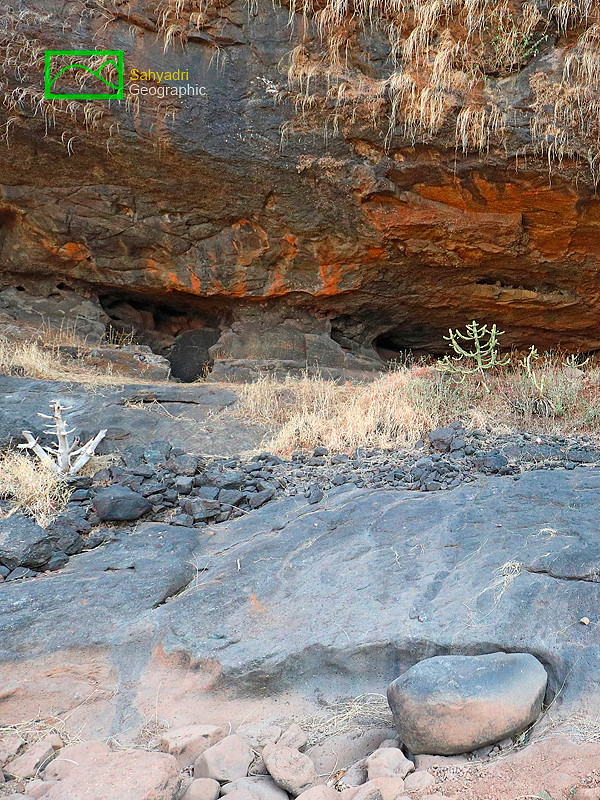 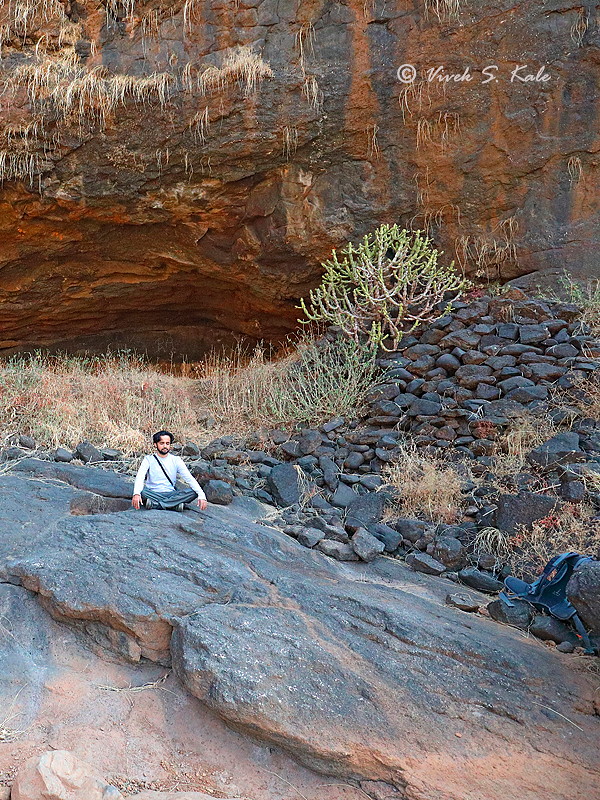 |
| |
| 1. Shilatane cave, Maval Tehsil, Pune district, Maharashtra, India |
| |
|
|
शिलाटणे लेण्याचा वेध :
फर्ग्य़ुसन च्या पुस्तकातील शिलाटणे बद्दल ची वाक्ये : “Again, on the south side of the village of Sheletana is a large covered rock cistern, originally with six openings, and high up the hill to the north is a large cavern under a waterfall. In the north side is a round hole which has been fitted with a cover, and was perhaps intended for storing grain. Beside this is a small circular chamber which may have contained a structural relic-shrine or daghoba. The roof of the cave has fallen in, and there has been a great flaw in the rock, which perhaps led to the cave never being finished.”
मी बरेच वर्ष फर्ग्युसन च्या पुस्तकातील शिलाटणे बद्दल च्या ओळी वाचायचो. येता जाता तो डोंगर न्याहाळायचो. लेणे आणि टाके सापडेल अशी मला अजिबात अपेक्षा नव्हती. उन्हाळ्याच्या एका सुट्टीच्या दिवशी मुहुर्त लागला. अमेय जोशी, साईप्रकाश बेलसरे, निनाद बारटक्के, मिलिंद लिमये आणि विवेक काळे असे आम्ही पाच जण भल्या सकाळी शिलाटण्याला पोहोचलो. गावात गुहेबद्दल चौकशी केली. अंदाज घेत डोंगर चढायला सुरुवात केली. सुरुवातीच्या अलगद चढानंतर छातीवर येईल असा चढ लागला. पायथ्यावरुन दिसणारी कपार दिसणे बंद झाले. एका उंचीवर आल्यावर घसाऱ्यावरच आडवे आडवे जात कपारीचा शोध ग्यावा लागला. थोडे वर चढायचे आणि आडवे जाउन उभ्या कातळात दगडांकडे कपारीबद्दल चौकशी करायची. नाही असे उत्तर मिळाले की परत फिरुन वरचा टप्पा गाठायचा, असा कार्यक्रम ४-५ वेळा केल्यावर अचानक आम्ही एका उभ्या कड़्यावर एका मोकळया जागेत पोहोचलो. वरुन येणाऱ्या ओढ्यात (कोरड़्या) आम्ही उभे होतो. वर ३०-४० मीटर अंतरावर कपार दिसत होती. आजुबाजुला गवत माजलेले होते. ऒढ्यातुनच आम्ही मोठया शिळा पार करत कपारीत पोहोचलो. समोरचे दृश्य फर्ग्युसननी १३८ वर्षांपूर्वी लेण्याबद्दल केलेल्या वर्णनाशी हुबेहुब मिळते जुळते वाटले. कपारीचे रितसर निरिक्षण करुन, मोजमापे घेतली गेली. नोंदवहीत नोंदी करण्यात आल्या. नोंदवहीत रेखाटन झाली. छायाचित्रे घेण्यात आली. ध्यान करण्यात आले. आजुबाजुचा परिसर न्याहाळण्यात आला.
|
|
Shilatane Cave Search:
We had few lines from Fergusson’s book as a clue, which are : “Again, on the south side of the village of Sheletana is a large covered rock cistern, originally with six openings, and high up the hill to the north is a large cavern under a waterfall. In the north side is a round hole which has been fitted with a cover, and was perhaps intended for storing grain. Beside this is a small circular chamber which may have contained a structural relic-shrine or daghoba. The roof of the cave has fallen in, and there has been a great flaw in the rock, which perhaps led to the cave never being finished.” I was amused of these lines for last few years.
With few lines from Fergusson’s book, five of us, Amey Joshi, Saiprakash Belsare, Ninad Bartakke, Milind Limaye and Vivek Kale reached Shilatane early morning of ahot summer. We intentionally decided to visit the place in summer, as it is not accessible in Monsoon. Though we had guessed the cavern from distance using binocular, several times before, we still were not sure about the exact location. After enquiry in village we realised that the cavern is the same, which we were guessing earlier. We started climbing the steep hill. As we climbed the hill for about 100 meters, we lost the sight of the cavern as the steepness was very high. After lot of probing from right to left eventually we reached the level of the cavern. This time the horizontal traverse probe was successful. We reached above the vertical cliff wall, in a large dry stream. We could see the cavern above us. However the only access is through the stream slope. We climbed up through the dry stream crossing the boudlers. All of a sudden we were in cavern. To our surprise the cavern exactly matched to what Fergusson had described 138 years back. We took measurements, took photographs, observed the minute details and noted the important observations. We also made rough sketches of the cave. After doing survey around the cave and observing the region around the hill, meditation was done.
|
|
|
| |
  |
| |
| 2. Shilatane cave map, Maval Tehsil, Pune district, Maharashtra, India |
| |
|
|
पुणे जिल्ह्यात, मावळ तालुक्यात कार्ले, भाजे आणि बेडसे येथे डोंगरांवर दगडात कोरलेली लेणी आहेत. मावळात या भागात, इतरत्र सुद्धा लहान विहार आणि लेणी आहेत. यातील एक लहान अपरिचित लेणे कार्ले लेण्याजवळ, शिलाटणे गावाजवळ डोंगरात आहे. जेम्स फर्ग्युसन आणि जेम्स बर्जेस या इंग्रज अभ्यासकांनी भारतातील लेण्यांचा रितसर अभ्यास करुन केव्ह टेंपल्स ऑफ इंडिया शीर्षकाचे पुस्तक १८८० साली प्रकाशित केले. त्यांनी नमुद केलेल्या मावळातील लहान लेण्यांमध्ये शिलाटणेचा उल्लेख आढळतो.
|
|
Around the famous Karle, Bhaje and Bedse Caves in Maval Tehsil of Pune district there are many smaller hermit caves in the hills. One of the interesting wonderful hermits is located in the hill near village called as Shilatane. This cave is not so well known and is not probably studied and documented. James Fergusson and James Burgess the noted explorers of Buddhist rock cut caves, around Pune have mentioned about this place in their book “Caves temples of India (1880)”.
|
|
|
| |
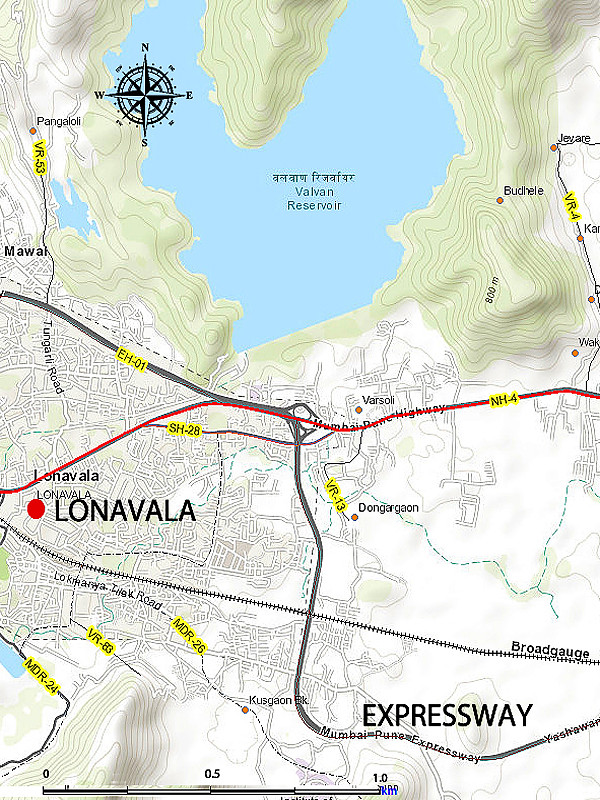 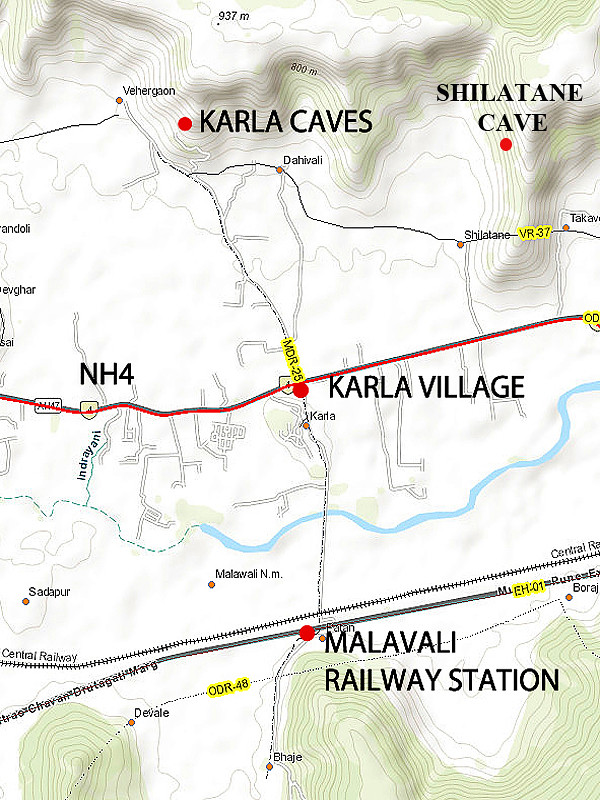 |
| |
| 3. Shilatane cave map, Maval Tehsil, Pune district, Maharashtra, India |
| |
|
|
शिलाटणे हे पुणे जिल्ह्याच्या मावळ तालुक्यात असलेले एक गाव आहे. हे गाव सह्याद्रीच्या कार्ले डोंगररांगेच्या कुशीत वसलेले आहे. ही डोंगररांग लोणावळेच्या उत्तरेस पश्चिम घाटापासुन पूर्वेकडे वाळख गावापर्यंत, १३ कि मी पसरलेली आहे. कार्ले डोंगररांग पश्चिम-पूर्व पसरलेली आहे, याच रांगेत कार्ले लेणी आहेत. कार्ले डोंगररांगेच्या दक्षिणेस समांतर विसापुर डोंगररांग पसरलेली आहे. विसापुर डोंगररांग पश्चिम घाटातील कुरवंडे गावापासुन पूर्वेला घोरावाडी डोंगरापर्यंत ३५ किमी पसरलेली आहे. विसापुर डोंगररांगेत, भाजे लेणी, बेडसे लेणी, लोहगड किल्ला, विसापुर किल्ला आणि शेलारवाडी लेणी या महत्वाची वारसा स्थळ आहेत. शिळा म्हणजे मोठे दगड. शिलाटणे या गावाच्या नावाचा अर्थ, "असे गाव जे कातळावर वसलेले आहे" असा होतो. हे गाव कातळावर वसलेले आहे.
|
|
Shilatane is a village in Maval Taluka in Pune district in the state of Maharashtra in India. The village is located at the base of the hill range on the Deccan plateau. This hill range, which is about 13 km in length, is spread from the western ghat ridge north of Lonavala up to the village Walakh towards east. It is spread in west-east orientation. Karle caves are located in the southern scarp of this hill range. Further south another west-east oriented hill range is spread over about 35 km, from Kurvande at western ghat main ridge up to the Ghoravadi towards east. This hill range has important archaeological sites such as Bhaje caves, Lohgad, Visapur and Shelarwadi caves. The name “Shilatane”, literally means “the one which is located on the rocks”. The name sounds ancient with the sanskrit word “Shila” for rock as a base word. The village is really and literally located on basalt rocky area.
|
|
|
| |
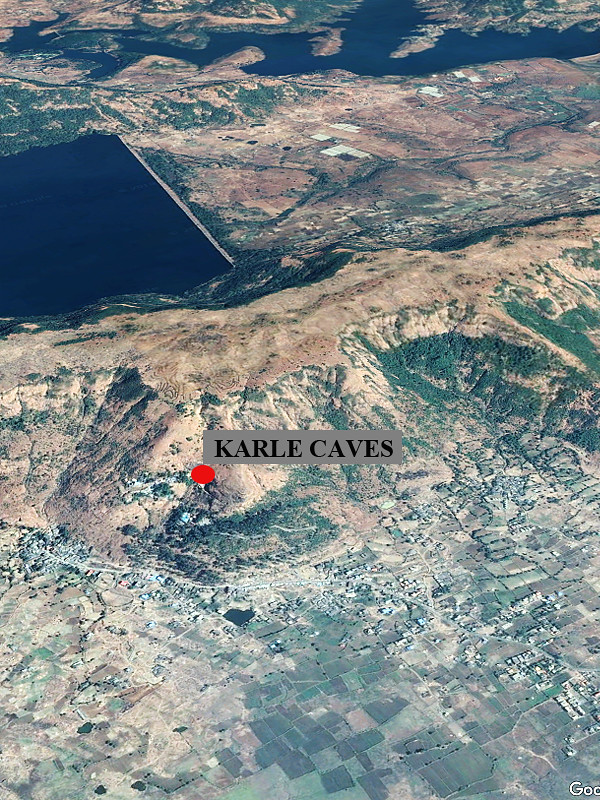 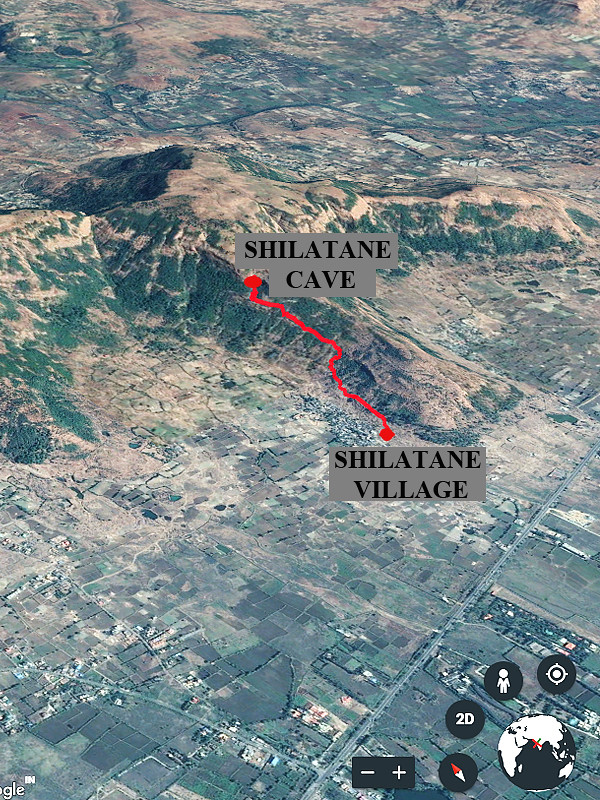 |
| |
| 4. Shilatane cave map, Maval Tehsil, Pune district, Maharashtra, India |
| |
|
|
कार्ले आणि विसापुर लेण्याच्या मधे असलेल्या पठारी प्रदेशातुन इंद्रायणी नदी वाहते. इंद्रायणी पश्चिमेकडुन पूर्वेकडे वाहते. प्राचीन व्यापारी मार्ग या भागातुन इंद्रायणी खोऱ्यातुन जातो. हा प्राचीन व्यापारी मार्ग कोकणातल्या कल्य़ाण, सोपारा या बंदरांपासुन दक्खन च्या पठारावरच्या पैठण, तेर या गावांना जोडत होता. आज याच भागातुन मध्य रेल्वे आणि मुंबई-पुणे राष्ट्रीय मार्ग जातात. शिलाटणे गाव कार्ले डोंगररांगेच्या पूर्व बाजुस, प्राचीन व्यापारी मार्गावर वसलेले आहे. हे गाव मुंबई-पुणे राष्ट्रीय मार्गापासुन अर्धा किलोमीटर आत आहे.
|
|
Between Karle hill range and Visapur hill range, the Indrayani river flows from west to east, and the plateau is called as Indrayani basin. The ancient trade route climbs up the western ghat ridge from the Konkan over to the Deccan plateau at Lonavala at the western end of this river basin. This ancient trade route was used to transport the goods from to the eastern economic centres on the Deccan plateau to Kalyan and Sopara ports on the western coast. Today the modern Mumbai-Pune road and rail line passes through the same Indrayani river basin, which was used for ancient trade in the past. Shilatane village is located on the southern base of Karle hill range east of Karle caves, close to the modern Mumbai-Pune old national highway (NH4), close to the eastern end of the Karle hill range.
|
|
|
| |
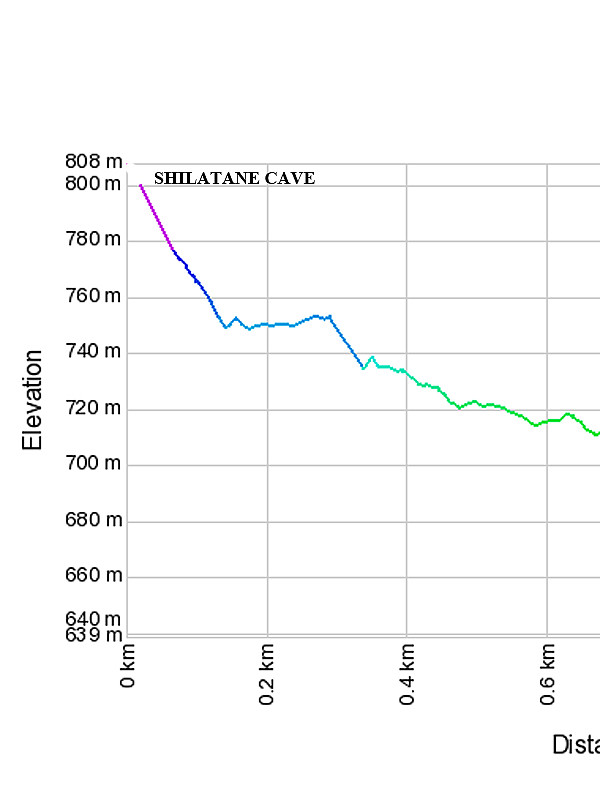 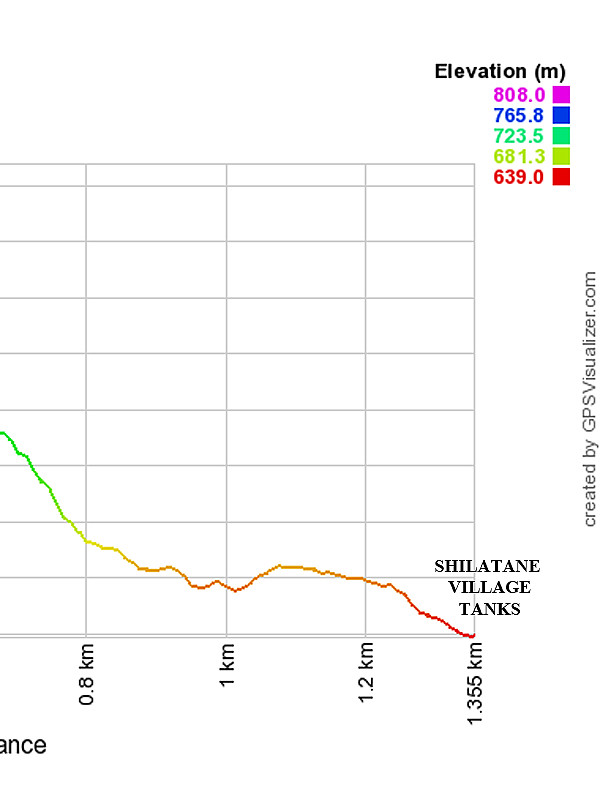 |
| |
| 5. Shilatane elevation chart, Maval Tehsil, Pune district, Maharashtra, India |
| |
|
|
शिलाट्णे गावाच्या उत्तरेकडे डोंगरात उंचावर उभ्या कातळात एक मोठी नैसर्गिक कपार आहे. येथे पावसाळ्यात मोठ्या प्रमाणात पाणी असल्याने येथे पावसाळ्यात जाणे धोक्याचे आहे. कपार गावापासुन अंदाजे एक कि.मी, अंतरावर, समुद्रसपाटीपासुन ८०० मीटर उंचीवर (गावापासुन १८० मीटर उंचीवर आहे). या ठिकाणी मोठा धबधबा आहे.
|
|
The hermit cave of Shilatane is located high up on the hill, north of Shilatane village in the natural rock cavern, formed under a large waterfall. As it rains very heavy in this region it is not recommended to reach this cavern in monsoon and postmonsoon season.The Shilatane cave is located at about 1 km north east of Shilatane village at about 180 meter elevation above the Shilatane village level. Elevation of the caves is 800 meter above mean sea level. Refer the maps shown for further details of this region
|
|
|
| |
 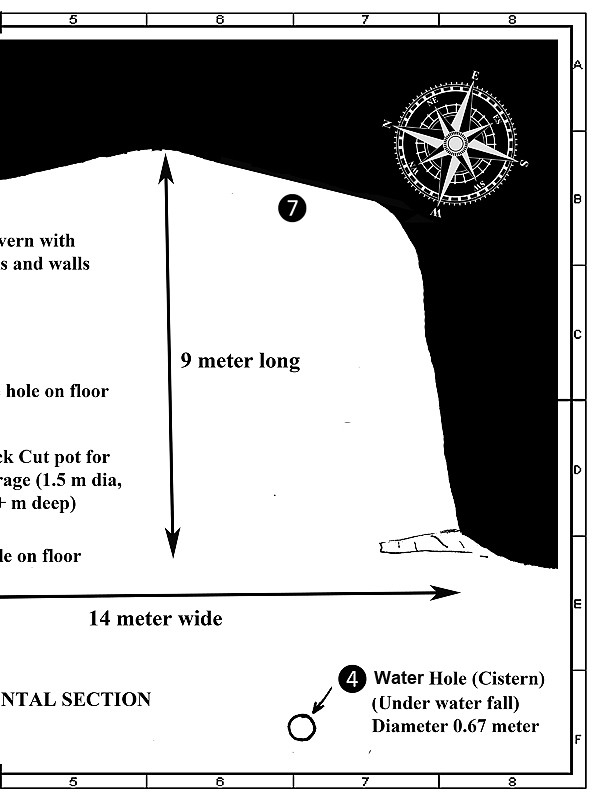 |
| |
| 6. Shilatane cave layout, Maval Tehsil, Pune district, Maharashtra, India |
| |
|
|
कार्ले डोंगररांग पश्चिम पूर्व पसरलेली आहे. या रांगेला कार्ले लेण्याच्या पुर्वेस एक दक्षिण उत्तर शाखा आहे. या डोंगरशाखेतल्या डोंगराची उंची ९४० मीटर (समुद्रसपाटी पासुन) आहे. शिलाटणे गावाची उंची ६२० मीटर (समुद्रसपाटी पासुन) आहे. शिलाटणे गावातील पाण्याची टाकी ६४० मीटर उंचीवर आहेत. गावापासुन बाजुचा हा डोंगर ३२० मीटर उंच आहे. या डोंगरावर गावापासुन १८० मीटर उंचीवर पाण्याच्या प्रवाहात धबधब्याखाली नैसर्गिक कपार लेणे आहे. नैसर्गिक कपार लेण्यात छतावर, भिंतींवर छन्नीच्या खुणा दिसतात. या लेण्यात उत्तरेकडे कपारीबाहेर दंडगोलाकृती लेणे आहे. दंडगोलाकृती लेण्याच्या उत्तरेकडे एक साधी पाठ नसलेली बैठक आहे. त्याच्या दक्षिणेकडे पाठ असलेली बैठक (बाक) आहे. बैठकीच्या दक्षिणेला कपार आहे. या कपारीत दगडात कोरलेला मोठा रांजण (टाकी) आहे. कपारीच्या मागच्या बाजुला काही भागात भिंत आहे. बाहेर धबधब्याखाली एक लहान पाण्याचे टाके आहे. पावसाळ्यात या ठिकाणी मोठा धबधबा आणि प्रवाह असतो. लेण्याकडे जाणारी वाट याच प्रवाहातुन जाणारी असल्याने पावसाळ्यात या ठिकाणी पोहोचणे अवघड आणि धोक्याचे आहे.
|
|
Cave : The hill extension, spread north south off the main west-east Karle hill range, east of Shilatane is about 940 meter elevated above mean sea level. Shilatane village on its west flank is located at about 620 meter above mean sea level. The Shilatane water cisterns in the village are located at about 640 meter altitude. The hill adjoining Shilatane is about 320 meter above the village elevation. At about 2/3rd level of this hill elevation, at about 800 meter altitude there is a large cavern located under the waterfall. The waterfall is dry post winter, and the water stream is very active in monsoon and in post monsoon season. There is a large natural cavern under the waterfall. The surface of natural cavern is chiselled, on roof and side walls. There is a small circular chamber at the caves, at the north end outside the cavern. There are benches on either side of the cylindrical chamber. Further south, there is also a rock cut pot in cavern, for either storage of grains or for storage of water. There is a small rock cut man made water hole under the water fall just outside the cavern.
|
|
|
| |
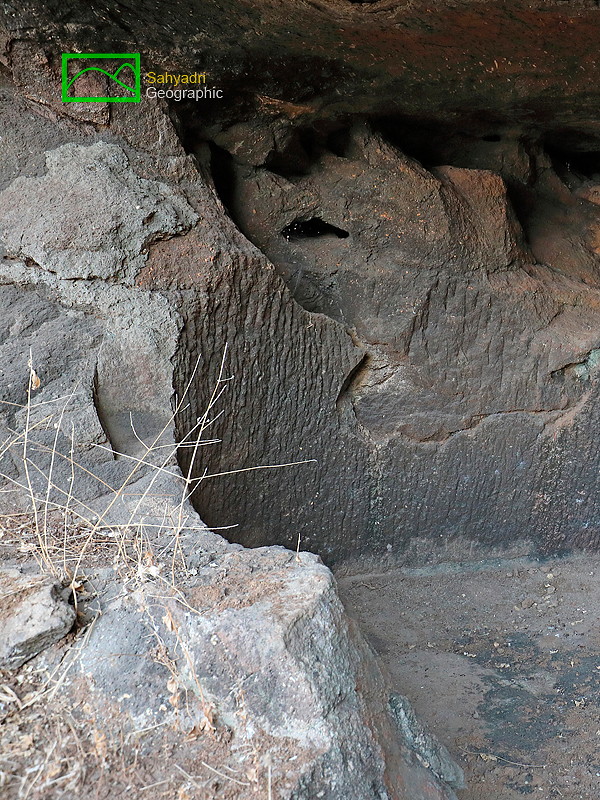 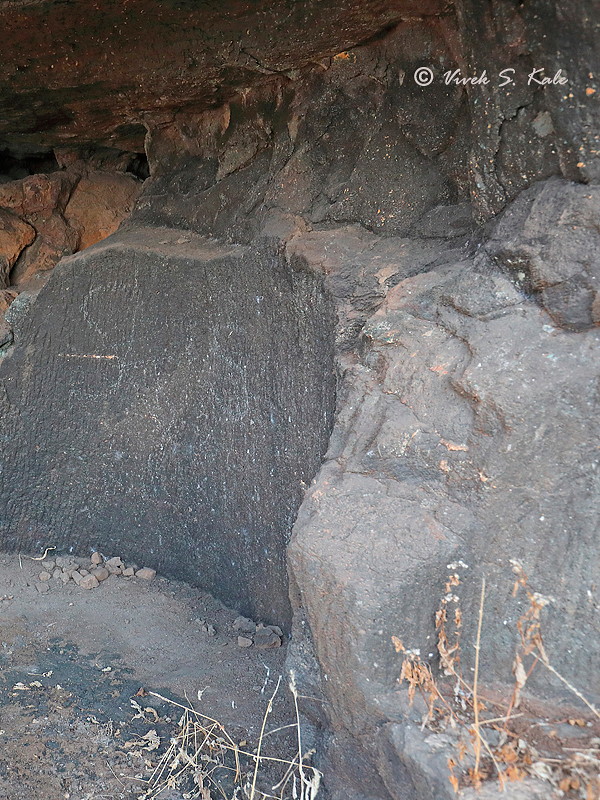 |
| |
| 7. Cylindrical Chamber, Shilatane Cave, Maval Tehsil, Pune district, Maharashtra, India
|
| |
|
|
दंडगोलाकृती चैत्य लेणे : शिलाटणे कपार लेण्याच्या उत्तर टोकाला कपारीबाहेर च्या कातळात एक दंडगोलाकृती लेणे आहे. या लेण्याचा खालचा भाग दंडगोल असुन छत आणि जमीन सपाट आहे. लेण्यात वरच्या भागात भिंत नैसर्गिक ओबड्धोबड असुन यात कपारी आणि कातळात रुतलेले लहान दगड आहेत. जमिनीपासुन छत २ मीटर उंच आहे. या लेण्याचा व्यास २ मीटर आहे. लेण्याला प्रवेशद्वार असाव असा अंदाज येथे जमिनीवर असलेल्या खळग्यावरुन बांधता येतो. मावळात अशा दंडगोलाकृती लेण्यांची कमी नाही. जेम्स फर्ग्युसन, जेम्स बर्जेस आणि एस. नागराजु यांच्या मते असे लेणे स्तुपासाठी बनवले असावे. मावळातल्या काही लेण्यात असे दंडगोलाकृती चैत्यगृह आहेत. बेडसे, भाजे येथे अशा दंडगोलाकृती चैत्यगृहात कोरलेला स्तुप आहे. तर भाजे, शिलाटणे, येलघोळ, वाळख, आणि खडकवाडी येथे अशा दंडगोलाकृती चैत्यगृहात कोरलेला स्तुप नाही. याचा अर्थ येथे दगड विटांपासुन बांधलेला किंवा लाकडाचा बांधीव स्तुप असावा. आज मात्र या ठिकाणचे दंडगोलाकृती चैत्यगृह लेणे रिकामे आहे. कोकणात कोंडिवते, कान्हेरी आणि जुन्नरजवळ तुळजा लेण्यात सुद्धा असे दंडगोलाकृती चैत्यगृह आहेत.
शिलाटणे च्या या दंडगोलाकृती चैत्यलेण्याबाहेर, दोन्ही बाजुला बैठकी (बाक) आहेत. उत्तरेकडच्या बैठकीला पाठ नाही. दक्षिणेकडच्या बैठकीला (बाकाला) मात्र पाठ आहे. ही बैठक १.८ मीटर लांब आणि ६५ सेंटी मीटर रुंद आहे. बाकाची उंची जमिनीपासुन ६७ सेंटी मीटर आहे. बाकाला मागे आणि दक्षिणेला पाठ आहे.
|
|
Circular chaityagriha chamber: There is a circular chamber on the north side of the main cavern. The empty chamber is about 2 meter in diameter. The lower section of this circular chamber is chiselled on its surface. The upper section of this chamber however has irregular wall with small rocks and cavities in the rock surface. The ceiling is about 2 meter above the flat floor. There are markings in the ceiling and floor indicating that there was a door frame at the entrance of this circular chamber. The circular chamber is as if for having structural stupa in it. Similar circular chambers can be seen at several other caves in Maval. The circular chambers at Bhaje and Bedse have carved stupa at the center. The other circular chambers at Khadakwadi, Yelghol, Walakh, Shilatane and Bhaje are empty and probably had structural stupa at its center. There are well known circular chaityagrihas at Kondivate, Kanheri in Konkan and at Tulaja cave complex near Junnar. These chambers are however empty today. Interestingly some of these chambers with and without carved stupa have same diameter. Outside this chamber at Shilatane cave, on either side, there is a provision of a bench. The bench on the south side of the entrance of the circular chamber is prominent. This bench is about 1.8 meter in length, 65 cm in breadth and 67 cm in height from the floor. The bench has tall backrest on backside and one south side. The bench and back wall has chisel marks.
|
|
|
| |
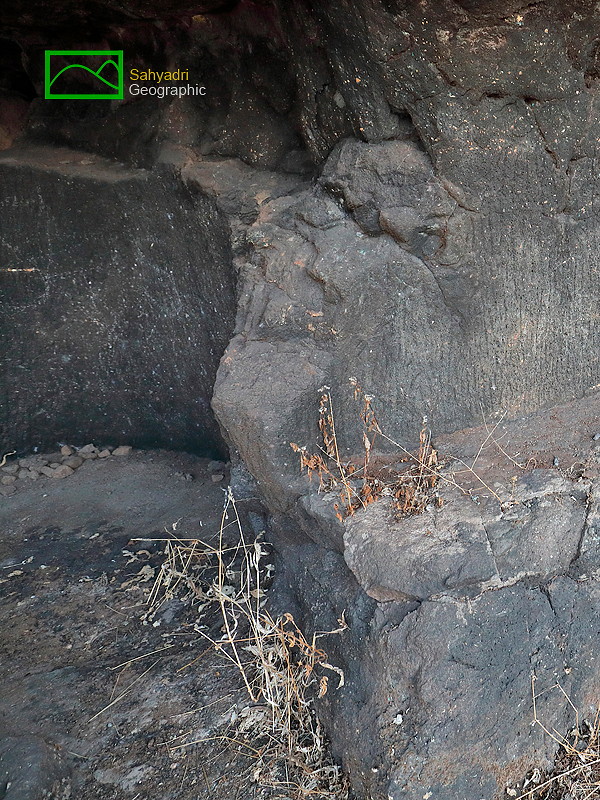  |
| |
| 8. Bench at Cylindrical Chamber, Shilatane cave, Maval Tehsil, Pune district, Maharashtra, India |
| |
|
|
| |
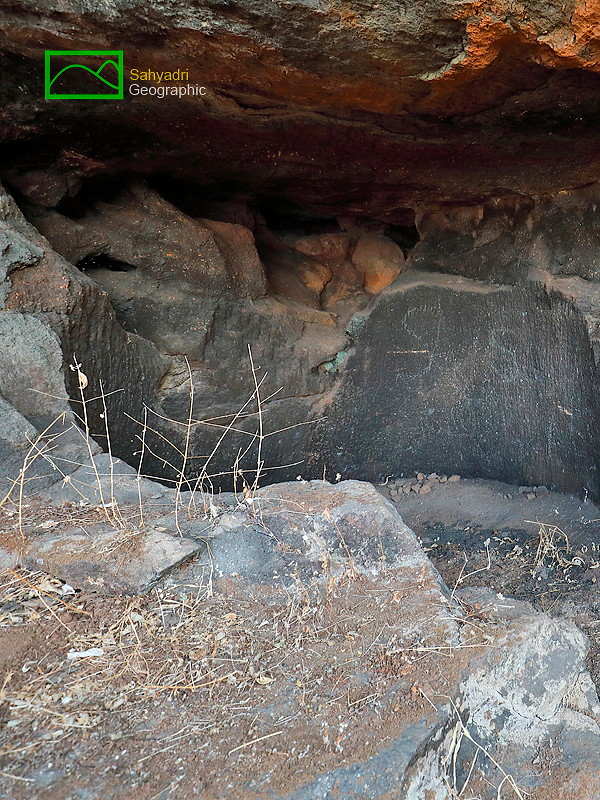 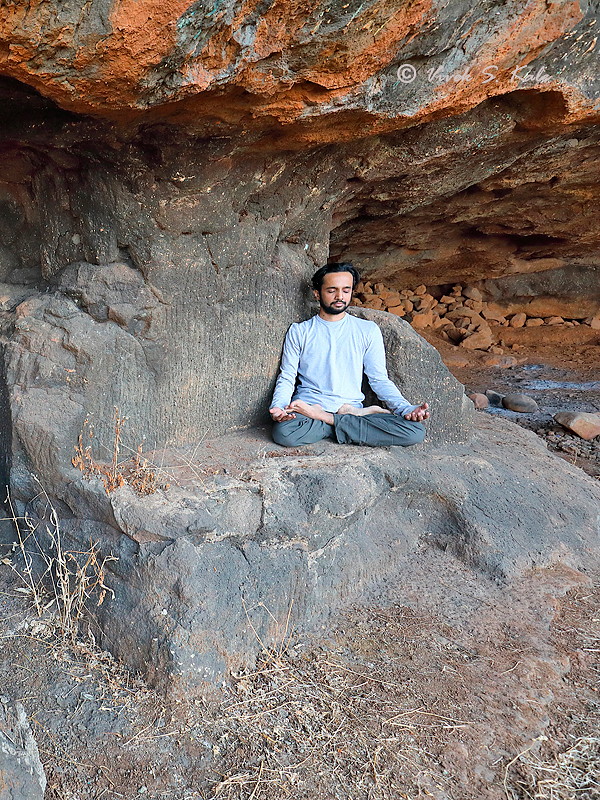 |
| |
| 9. Bench at cylindrical chamber, Shilatane cave, Maval Tehsil, Pune district, Maharashtra, India |
| |
|
|
| |
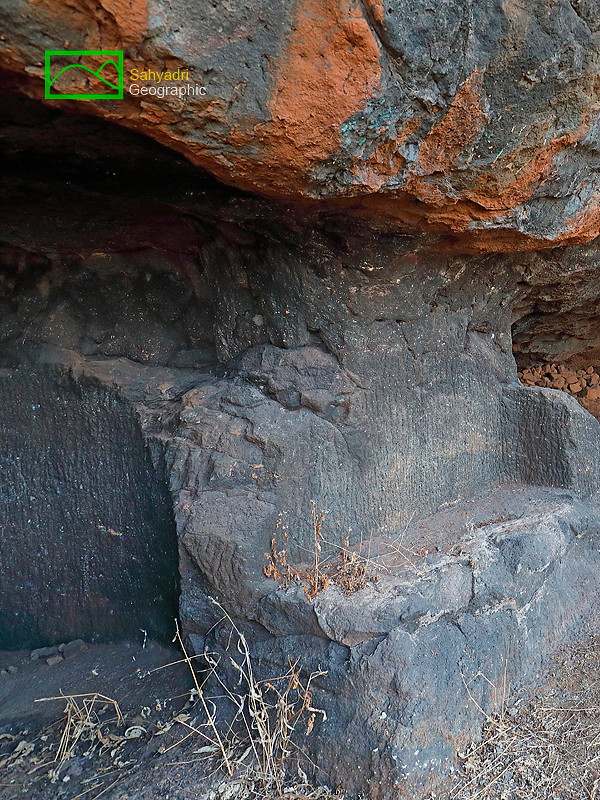 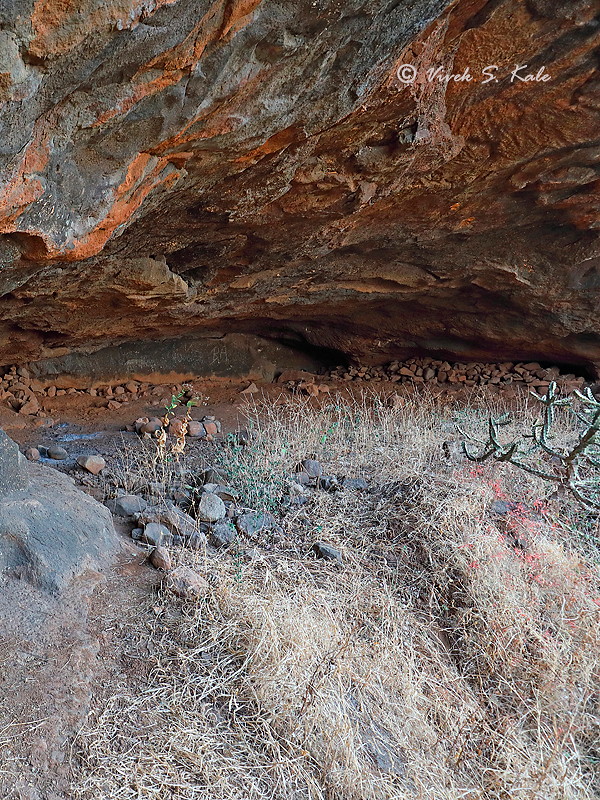 |
| |
| 10. Bench and Cavern, Shilatane cave, Maval Tehsil, Pune district, Maharashtra, India |
| |
|
|
| |
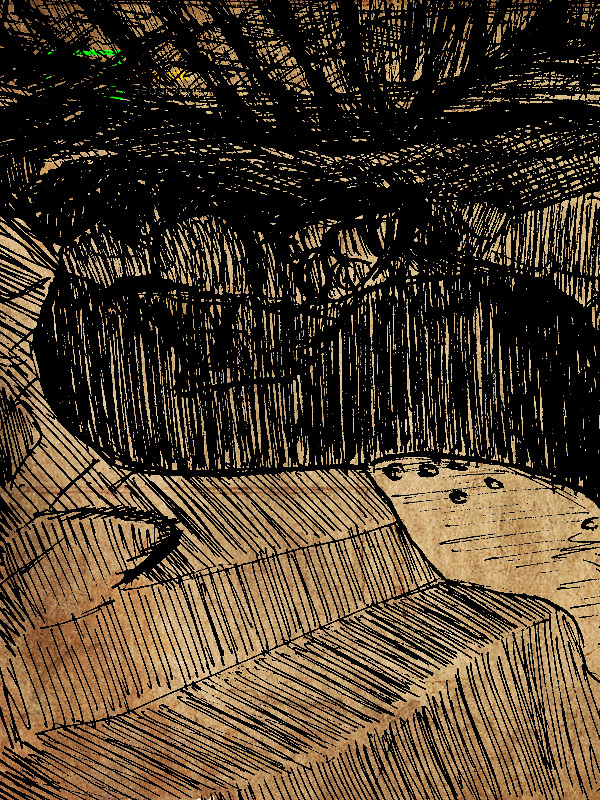 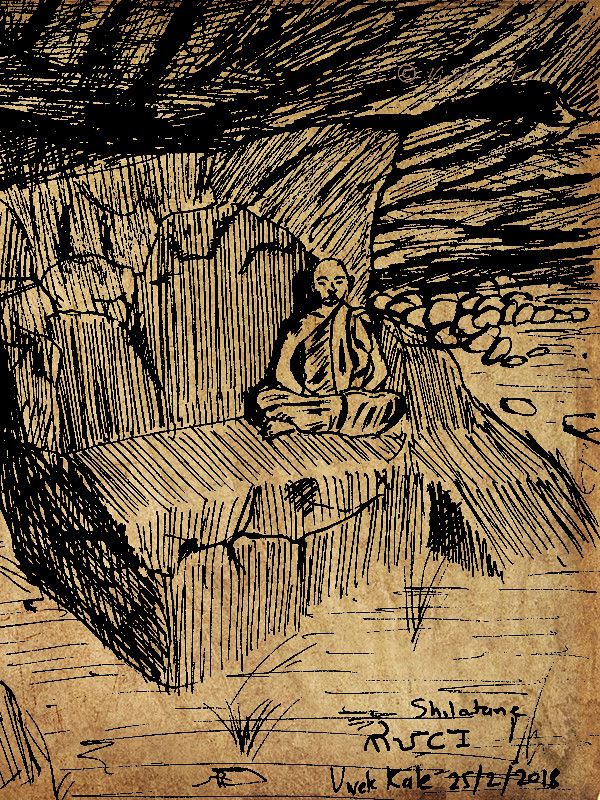 |
| |
| 11. Bench with the purpose, Shilatane cave, Maval Tehsil, Pune district, Maharashtra, India |
| |
|
|
| |
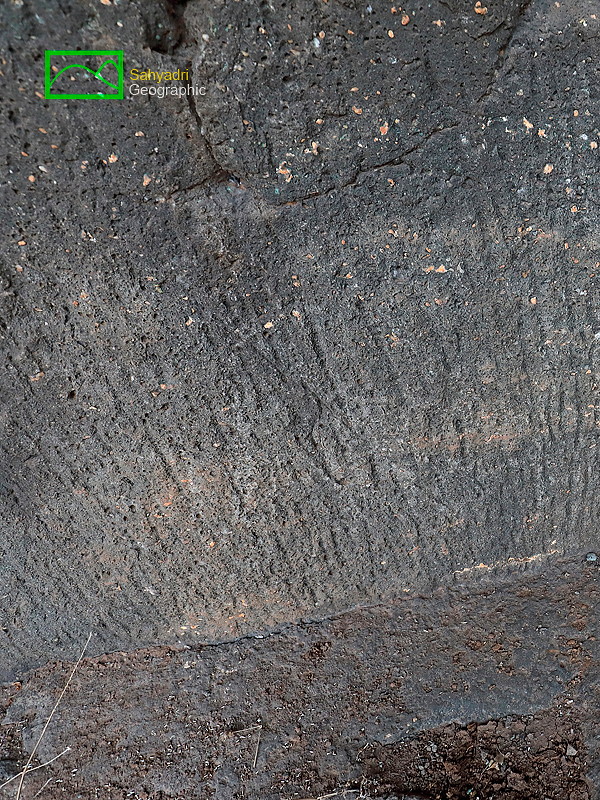 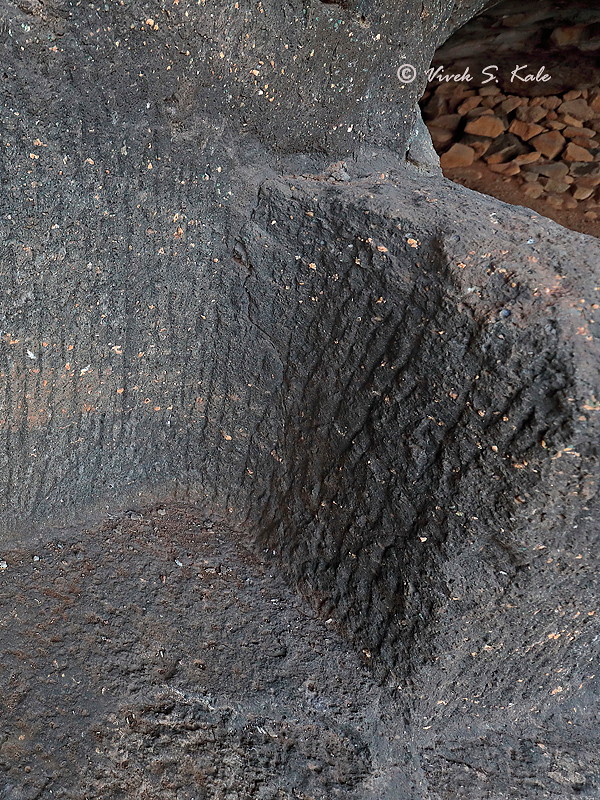 |
| |
| 12. Bench at Shilatane cave, Maval Tehsil, Pune district, Maharashtra, India |
| |
|
|
| |
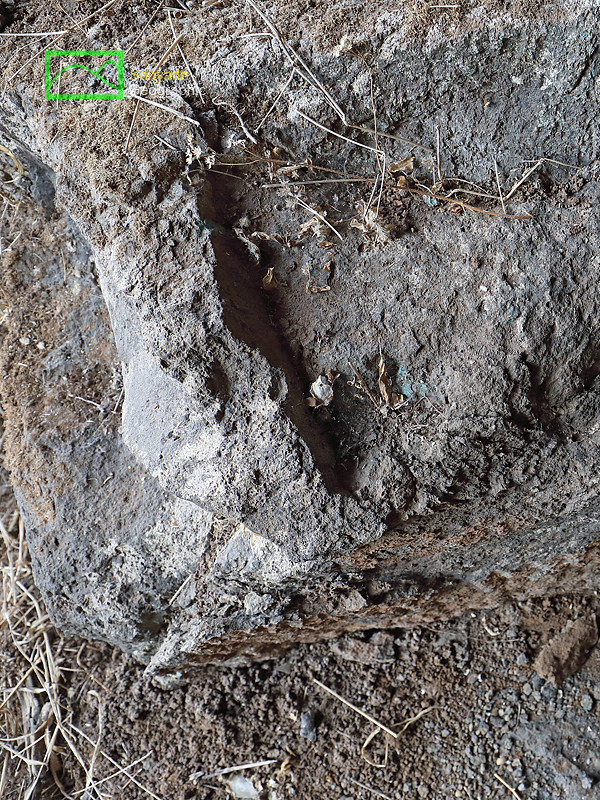 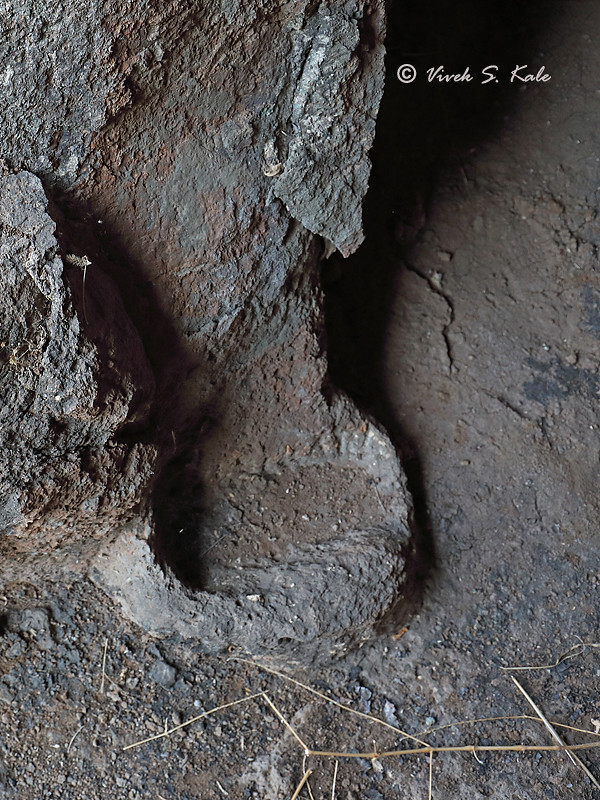 |
| |
| 13. Pole hole marks at Cylindrical chamber entrance, Shilatane cave, Maval Tehsil, Pune district, Maharashtra, India |
| |
|
|
| |
 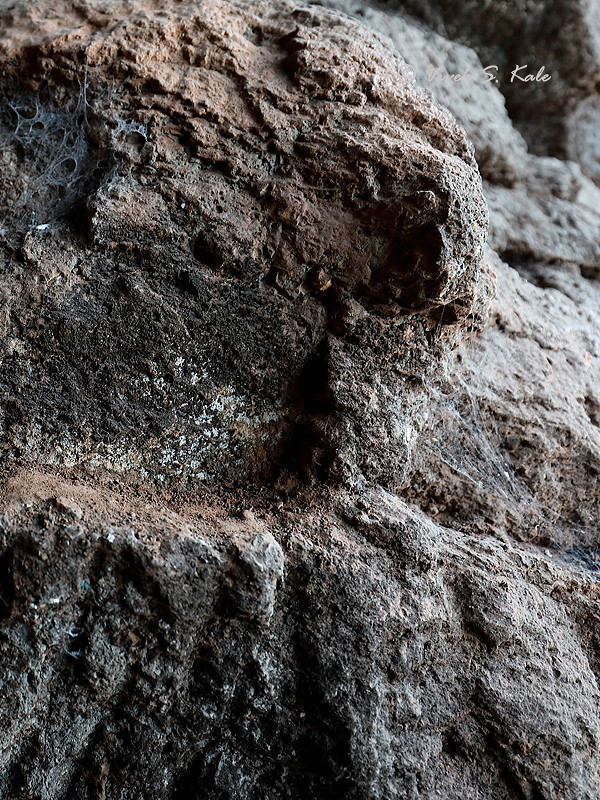 |
| |
| 14. Pole hole marks at Cylindrical chamber entrance, Shilatane cave, Maval Tehsil, Pune district, Maharashtra, India |
| |
|
|
| |
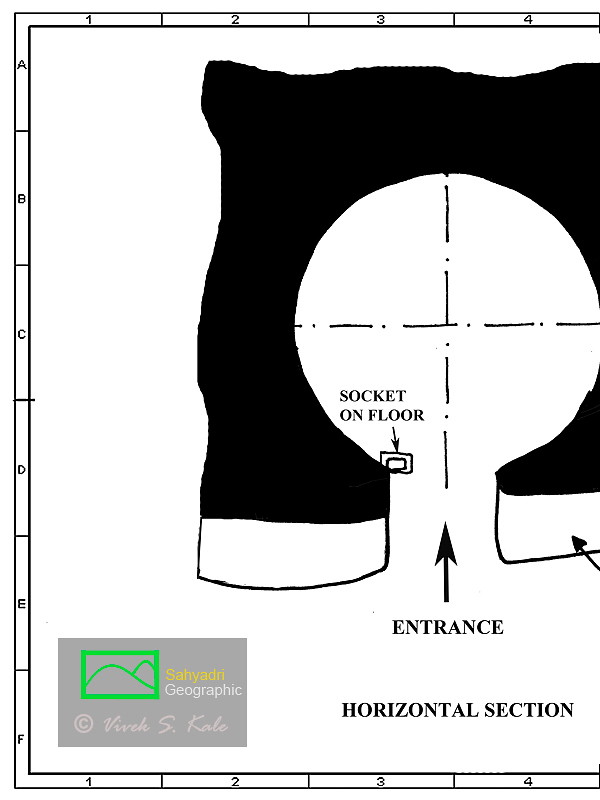 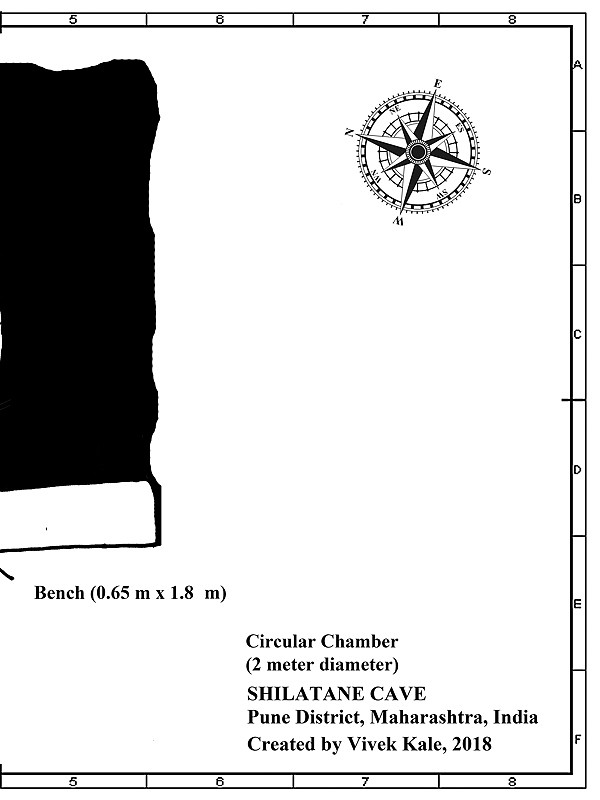 |
| |
| 15. Cylindrical chamber (Chaityagriha) Layout ,Shilatane cave, Maval Tehsil, Pune district, Maharashtra, India |
| |
|
|
| |
 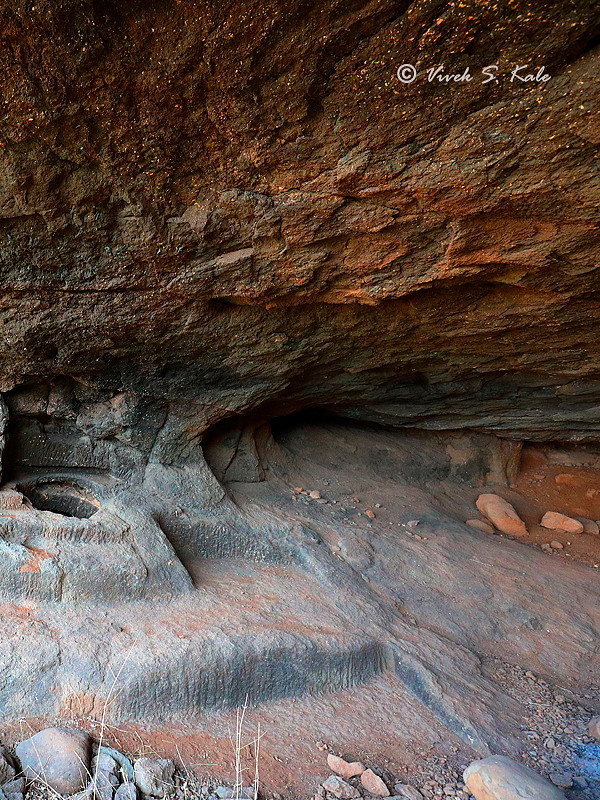 |
| |
| 16. Underground rock cut cistern, Shilatane cave, Maval Tehsil, Pune district, Maharashtra, India |
| |
|
|
दगडात कोरलेले टाके : कपार लेण्याच्या उत्तर बाजुस एक चौथरा आहे. या चौथऱ्यावर भिंतीलगत एक गोल तोंडाचे दगडात कोरलेले टाके आहे. टाक्याचा आतला आकार दंडगोलाकृती आहे. टाक्याच्या मानेचा भाग शंकु आकाराचा आहे. टाक़्याच्या वर भिंतीत खाचा आहेत. टाके झाकण्यासाठी वापरात असलेल्या झाकणासाठी या खाचा असाव्यात. झाकण पक्के बंद करण्यासाठी असलेल्या प्रणालीसाठी येथे अजुन काही खाचा दिसतात. चौथऱ्यावर काही खांब रोवण्यासाठी असलेले गोल खड्डे दिसतात. येथे वासे लावुन आडोसा केला असावा. जेम्स फर्ग्युसन आणि जेम्स बर्गेस यांच्या मते हे टाके पाण्याचे नसुन ते कदाचित धान्य किंवा इतर महत्वाच्या वस्तु ठेवण्यासाठी केले असावे. पण या टाक्याच्या वर असलेल्या कपारीतुन कदाचित या ठिकाणी पाणी येऊ शकते. मात्र पावसाळ्यात येथे जाणे अशक्य असल्याने याची पडताळणी पावसाळ्याअखेर निरिक्षण केल्यास समजुन येईल. सध्या या टाक्यात बरेच दगड आणि प्राण्यांची हाड आहेत. झाकणाच्या प्रयोजनाचा विचार केला तर मात्र हे टाके पाण्याव्यतिरिक्त काही तरी (धान्य वगैरे) साठवायला वापरले जात असावे असे वाटते, किंवा पाण्यात उंदीर अथवा इतर काही छोटे प्राणी पडु नयेत म्हणुन सुद्धा झाकण असण्याची शक्यता आहे. या टाक्याची क्षमता अंदाजे १६०० लिटर आहे. उन्हाळ्यात आम्ही पाहिले तेंव्हा यात पाणी नव्हते. अगदी असेच हुबेहुब टाके येलघोळ च्या कपार लेण्यात आहे. तेथे टाके स्तुपाजवळ चौथऱ्यावर आहे. झाकण लावायची सोय येलघोळ च्या टाक्याला सुद्धा आहे.
|
|
Rock cut pot in the cavern: On the northern end of the cavern, there is a rock cut underground storage pot. The rock cut pot has circular opening at top. The rock cut pot is cylindrical with smooth radius from the neck to the cylindrical surface. Above the rock cut pot there is a slit made on the back wall, as if to slide the wooden cover and lock it. There are couple of slots on west side of the pot, which suggest some locking mechanism, so that cover cannot be easily be displaced from its position. There are two pole posts on south side of the rock cut pot on the floor, as if to create a wall to hide this pot. As per analysis done by James Fergusson this rock cut pot was used to store the grain. There is rock wall, part of the cavern which overheads the rock pot with clearance of about 90 cm between the opening of rock cut pot and the overhead rock. There are many cavities in the overhead rock. As the place is wet with rock defects above it, it is likely that the water seeps in to the pot during the rainy season. Hence, though the rock cut pot is dry in dry season, there is a likelihood that in peak monsoon it may be filled with water. Hence, the hypothesis by James Fergusson that the pot was used to store the grain may not be valid. However, in spite of having overhead covering cavern rock, over the pot, the provision of the external cover fitment suggests that the pot might have been used for purpose more than storing the water. Currently the pot is filled with rocks and animal bones. Cover also might have been fitted to arrest the intrusion of mice and other small animals in to the pot. The volumetric capacity of the rock cut pot is about 1600 litre. There was no water in the pot when seen in February 2018. Almost similar container is there at Yelghol. The container at Yelghol also has provision of covering lid. The container at Yelghol is rock cut on the platform near Stupa. At Shilatane, the container is near cylindrical chamber.
|
|
|
| |
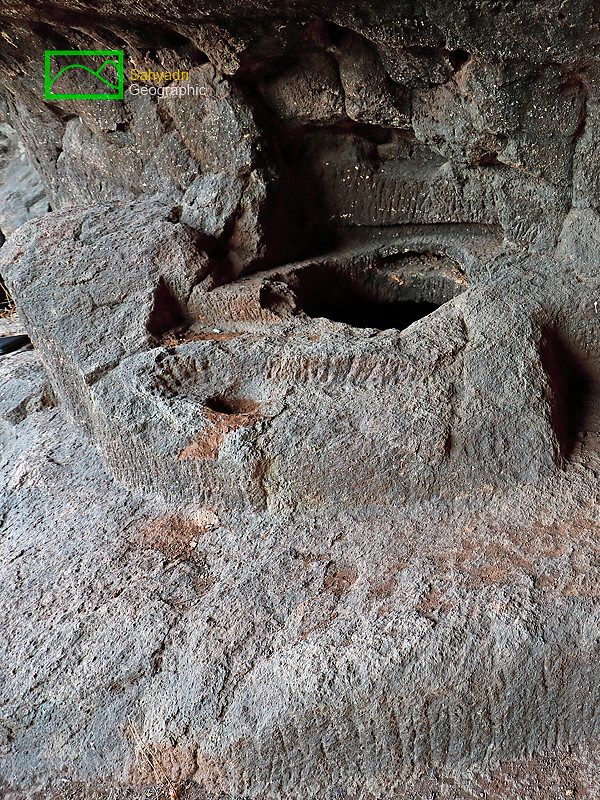  |
| |
| 17. Underground rock cut cistern, Shilatane cave, Maval Tehsil, Pune district, Maharashtra, India |
| |
|
|
| |
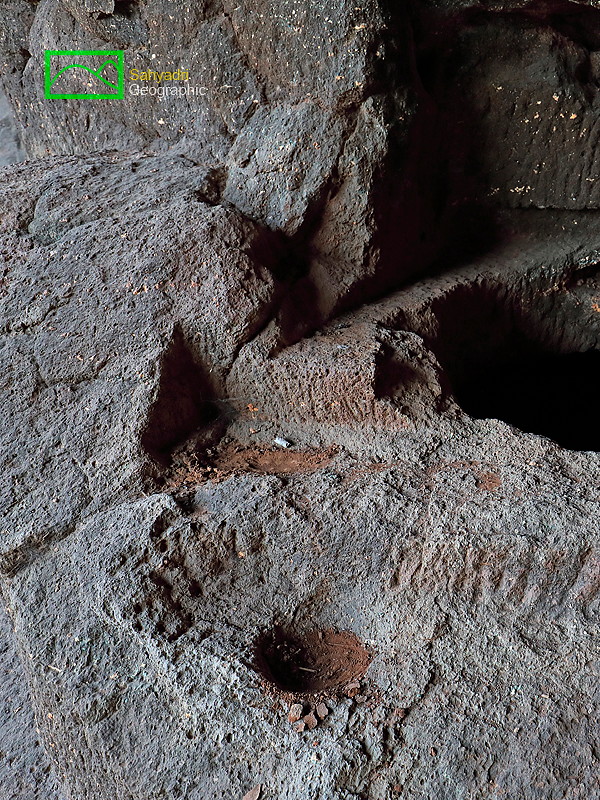 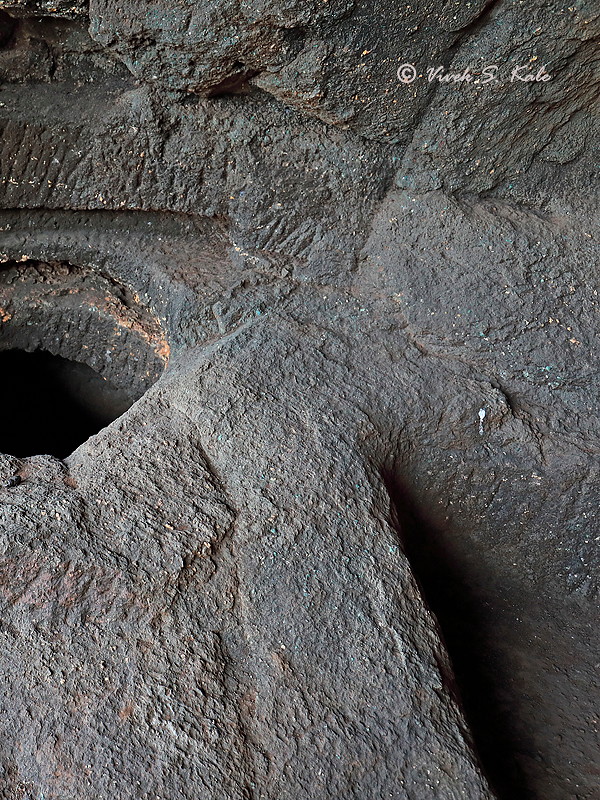 |
| |
| 18. Underground rock cut cistern, Shilatane cave, Maval Tehsil, Pune district, Maharashtra, India |
| |
|
|
| |
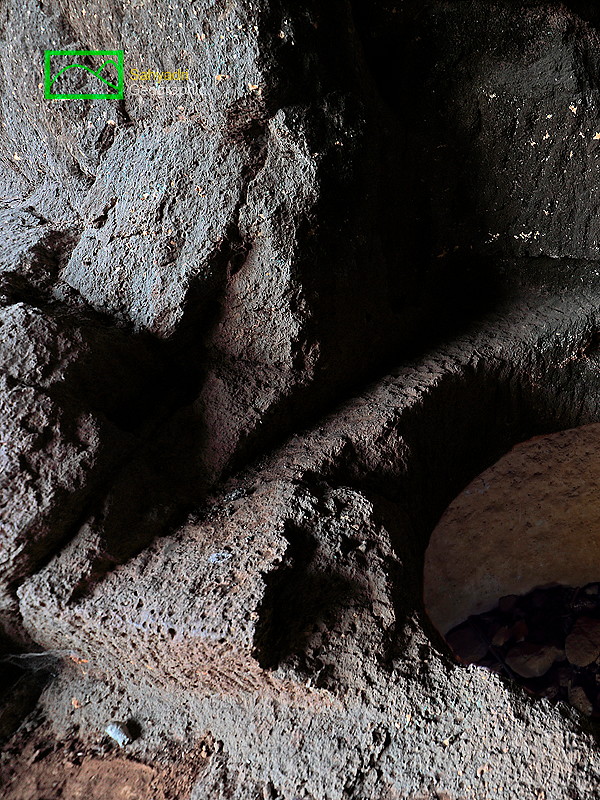 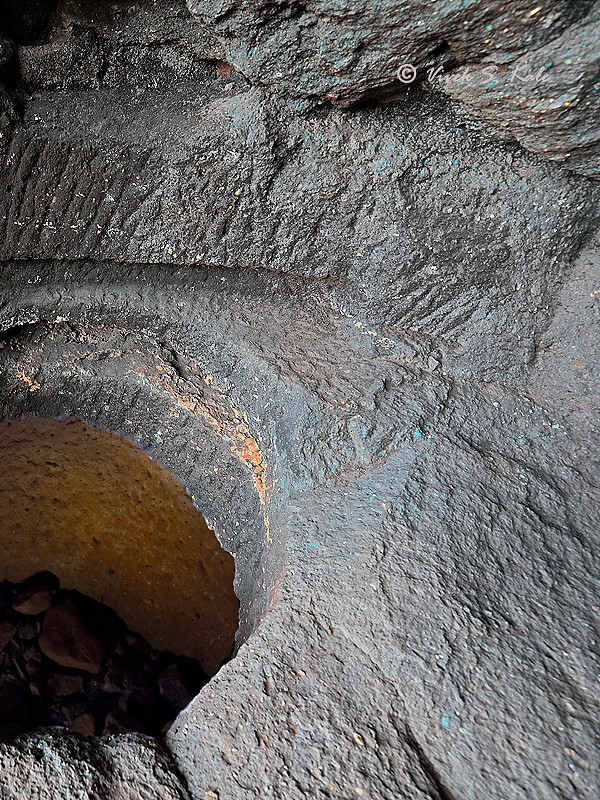 |
| |
| 19. Underground rock cut cistern, Maval Tehsil, Pune district, Maharashtra, India |
| |
|
|
| |
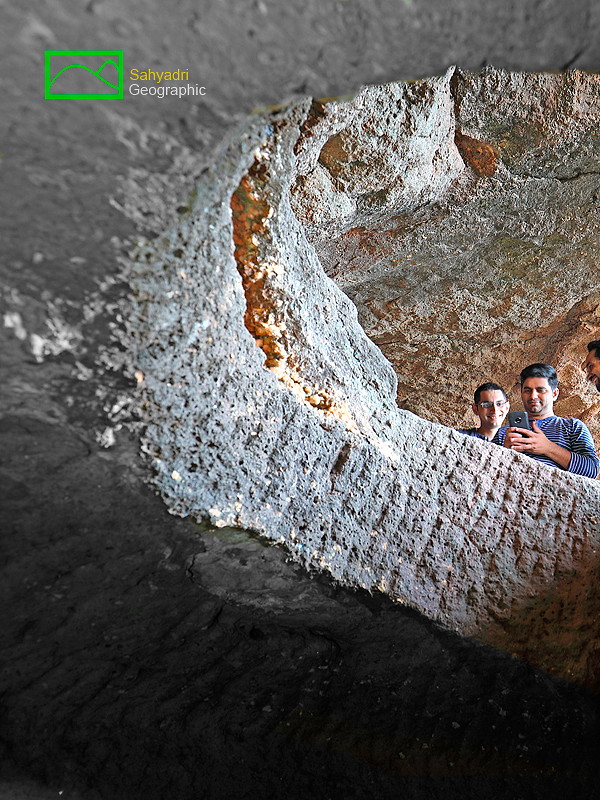  |
| |
| 20. From inside the underground rock cut cistern, Maval Tehsil, Pune district, Maharashtra, India |
| |
|
|
| |
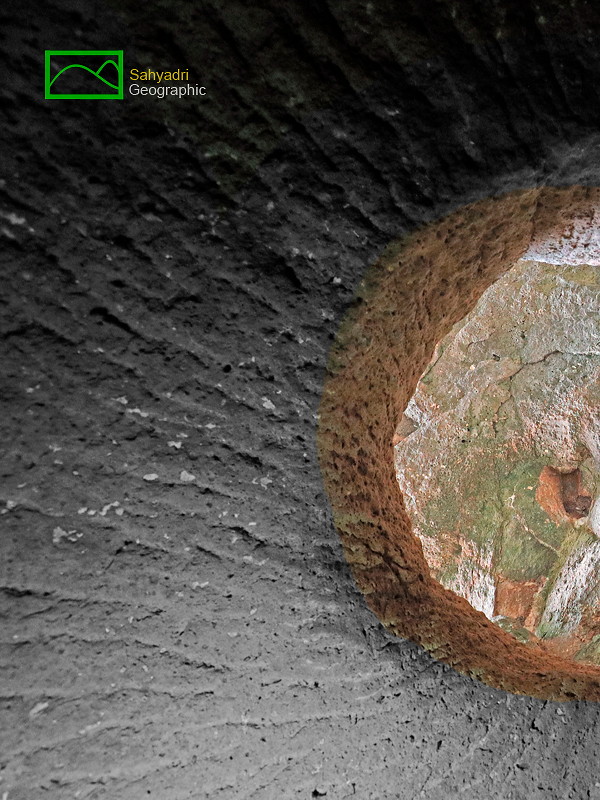 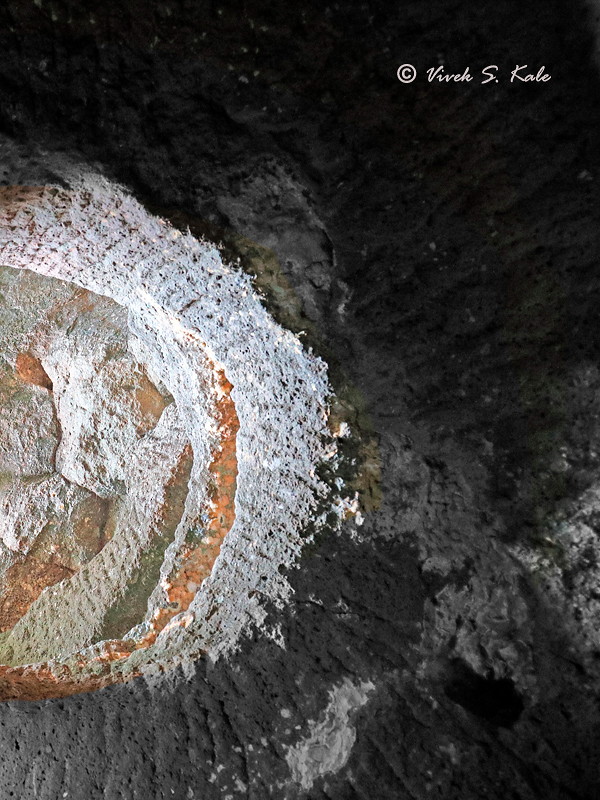 |
| |
| 21. From inside the underground rock cut cistern, Maval Tehsil, Pune district, Maharashtra, India |
| |
|
|
| |
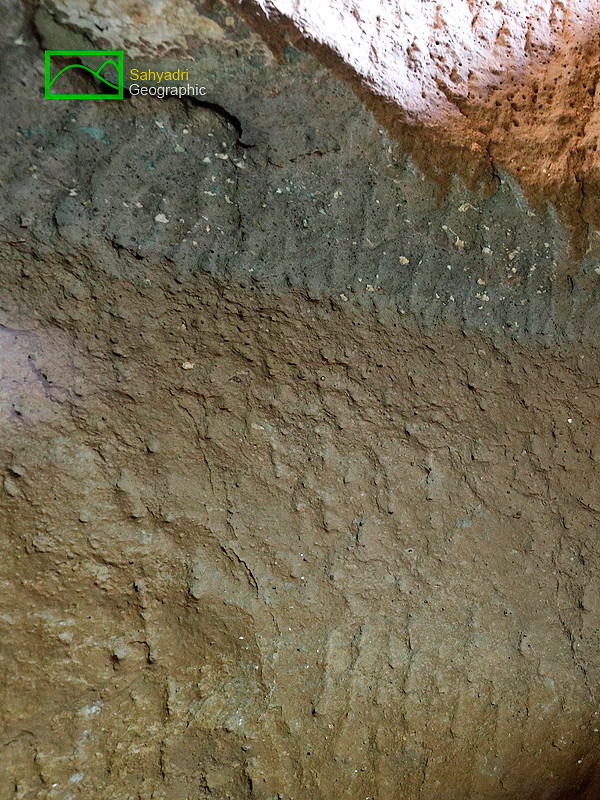  |
| |
| 22. From inside the underground rock cut cistern, Shilatane cave, Maval Tehsil, Pune district, Maharashtra, India |
| |
|
|
| |
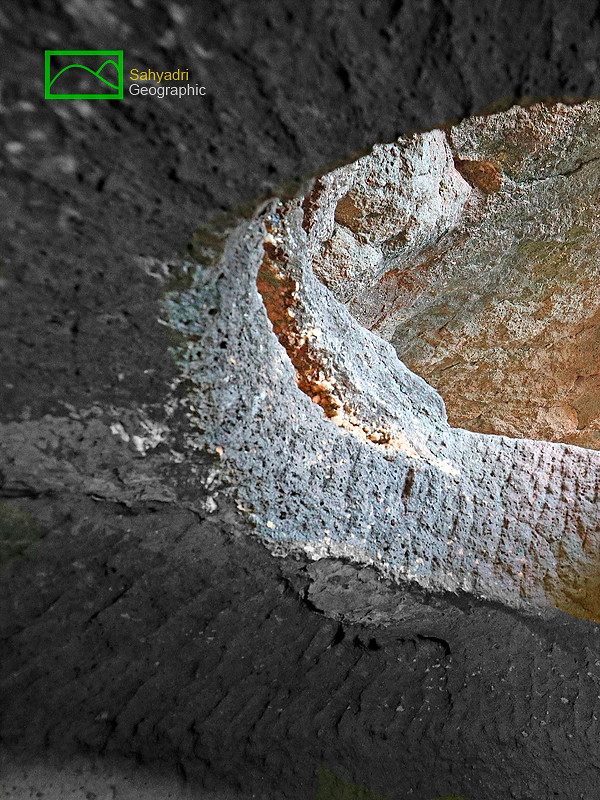 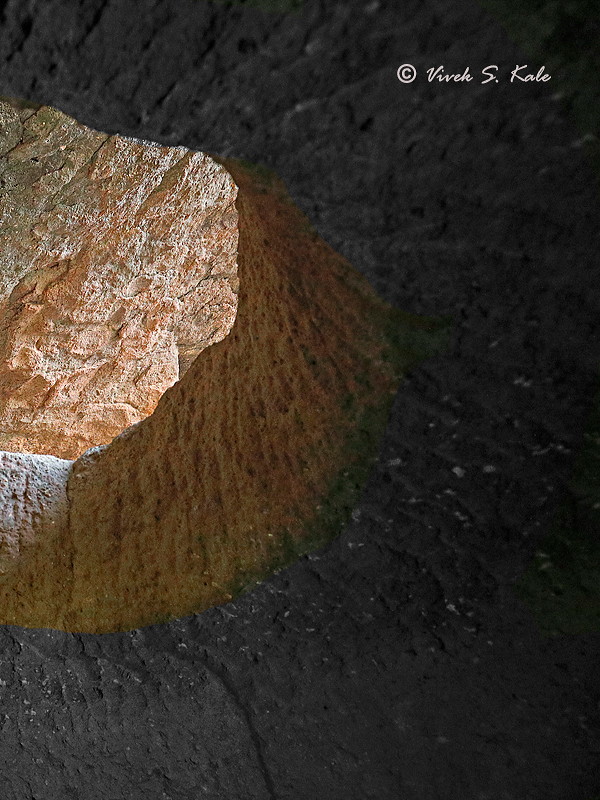 |
| |
| 23. From inside the underground rock cut cistern ,Shilatane cave, Maval Tehsil, Pune district, Maharashtra, India |
| |
|
|
| |
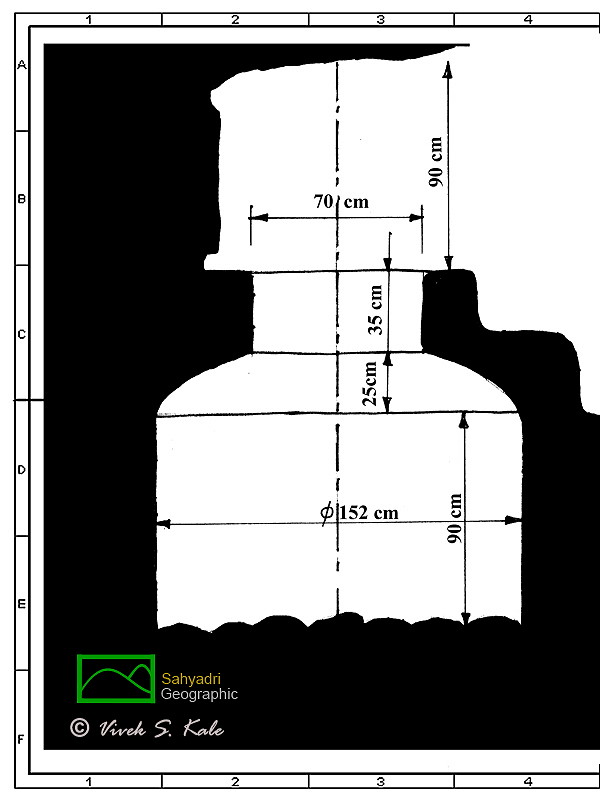 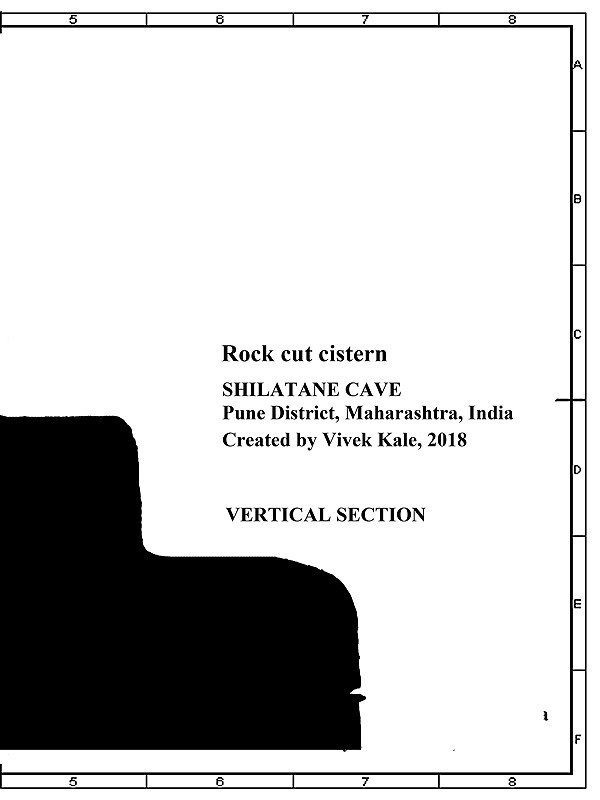 |
| |
| 24. From inside the underground rock cut cistern,Shilatane cave, Maval Tehsil, Pune district, Maharashtra, India |
| |
|
|
| |
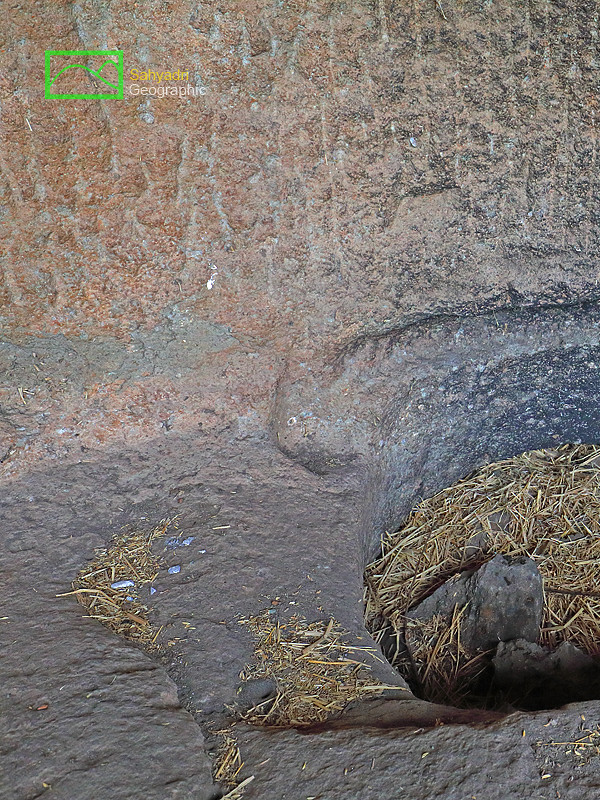 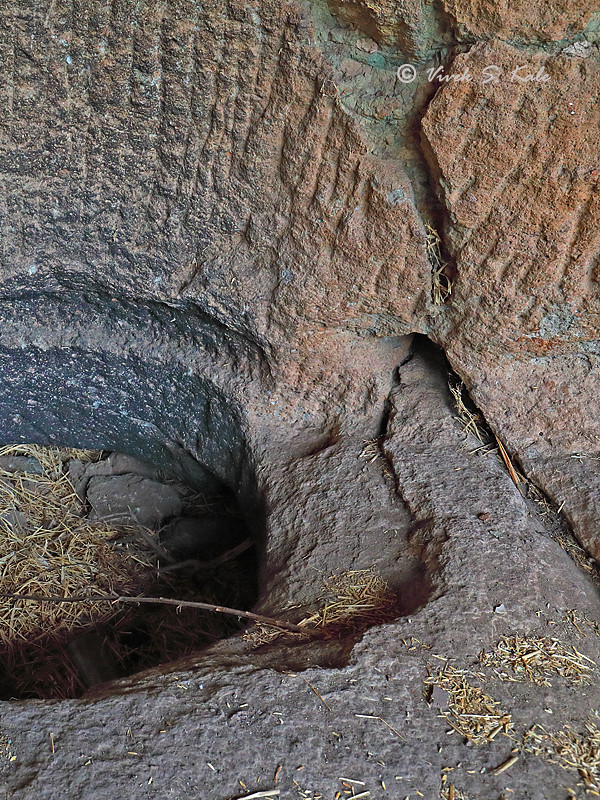 |
| |
| 25. Similar Underground rock cut cistern ,Yelghol buddhist cave, Maval Tehsil, Pune district, Maharashtra, India |
| |
|
|
| |
 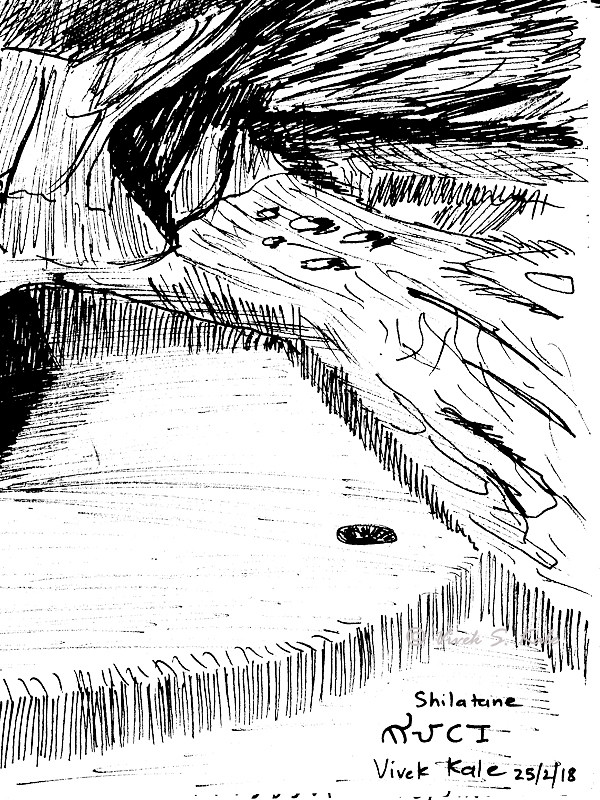 |
| |
| 26. Underground rock cut cistern, Shilatane cave, Maval Tehsil, Pune district, Maharashtra, India |
| |
|
|
| |
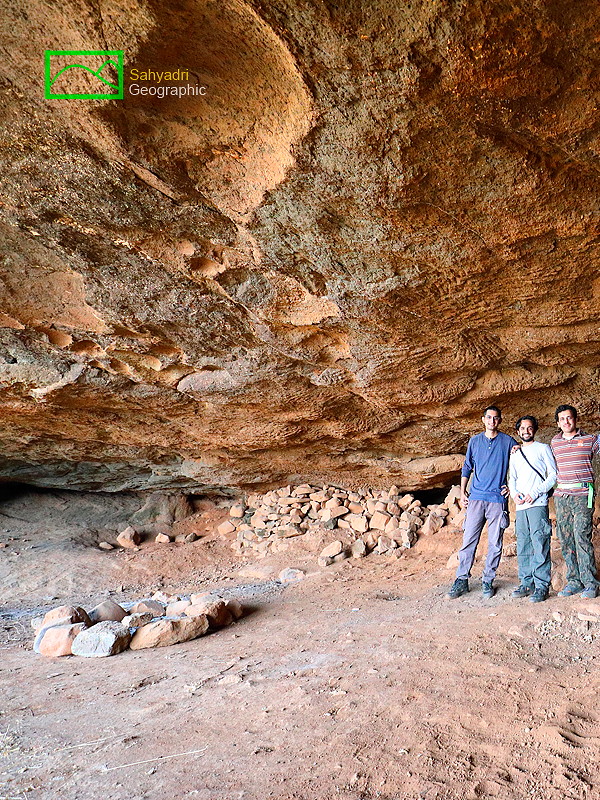 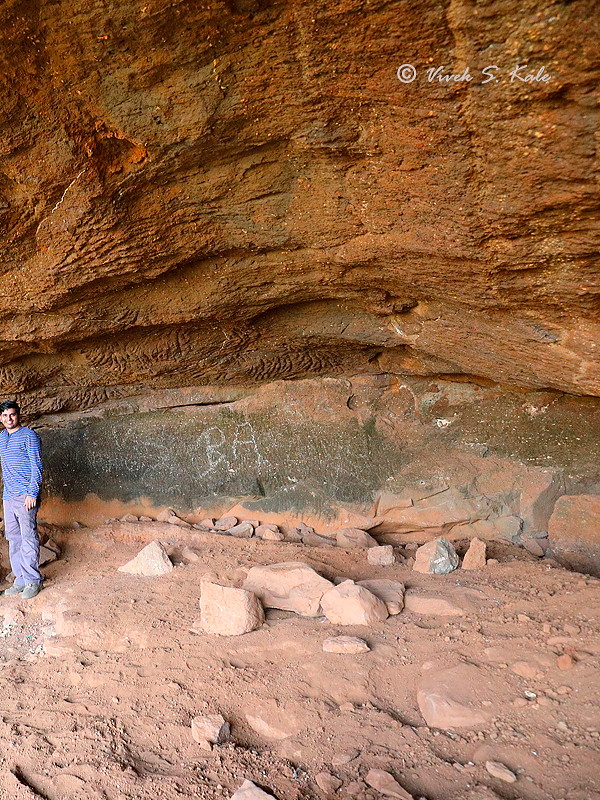 |
| |
| 27. Cavern, Shilatane cave, Maval Tehsil, Pune district, Maharashtra, India |
| |
|
|
कपार : नैसर्गिक कपार एका मोठया धबधब्याच्या खाली आहे. कपार समुद्रसपाटीपासुन अंदाजे ८०० मीटर उंचावर आहे. तर गावापासुन अंदाजे १८० मीटर उंचावर आहे. कपारीची रुंदी १४.५ मीटर आहे. कपार आत ९ मीटर रुंद आहे. दर्शनी भागात कपारीची उंची ४ मीटर आहे. छतावर छन्नीच्या खुणा आहेत. छत मात्र एका पतलात नसुन ओबडधोबड आहे. कपारीच्या आतल्या बाजुस एका पतलात असलेली उभी भिंत कोरलेली आहे. कपारीत इतरत्र मोठी भेग आहे. इथे भेगेलगत बरेच सुट्टे दगड आहेत. कपारीत दगडात कोरलेल्या टाक्याजवळ चौथरा आगे.
|
|
Cavern: The natural cavern is located on the Shilatane hill at about 800 meter above mean sea level. The cavern is about 14.5 meter wide and 9 meter deep, from front to back crevice wall. At the front the cavern is about 4 meter in height. There are chisel marks on the ceiling. The ceiling is irregular and is not flat. The part of the back of the cave is chiselled to make a flat vertical wall. The rest of the back of the cave has deep crack with voids in the crack, which are natural. The backside crack has been laid with small loose rocks. On the northern end of the cavern, there is a rock cut underground storage pot. There are couple of post holes on south side of this rock cut pot.
|
|
|
| |
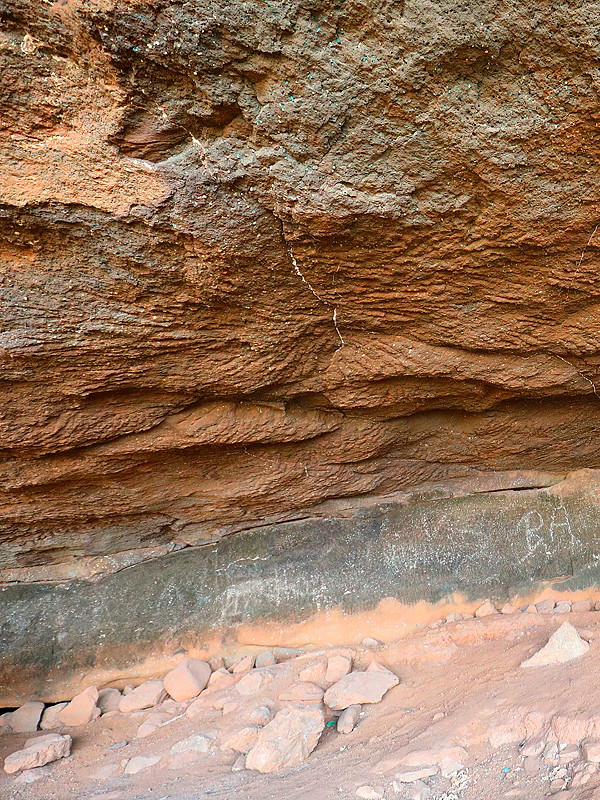 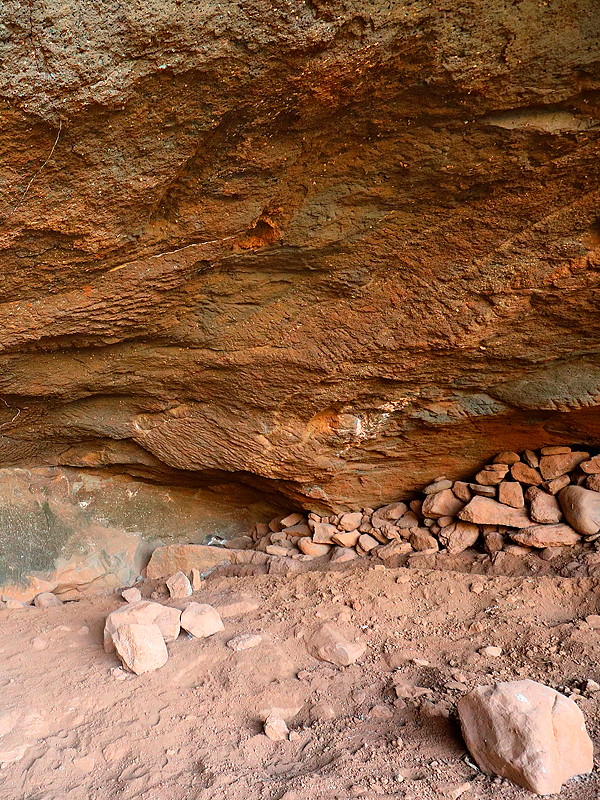 |
| |
| 28. Cavern with backwall chiselled, Shilatane cave, Maval Tehsil, Pune district, Maharashtra, India |
| |
|
|
| |
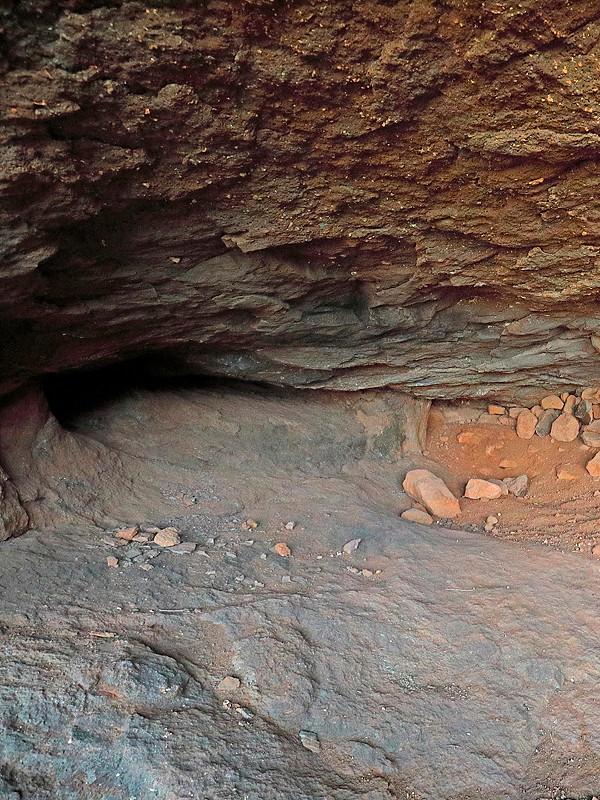 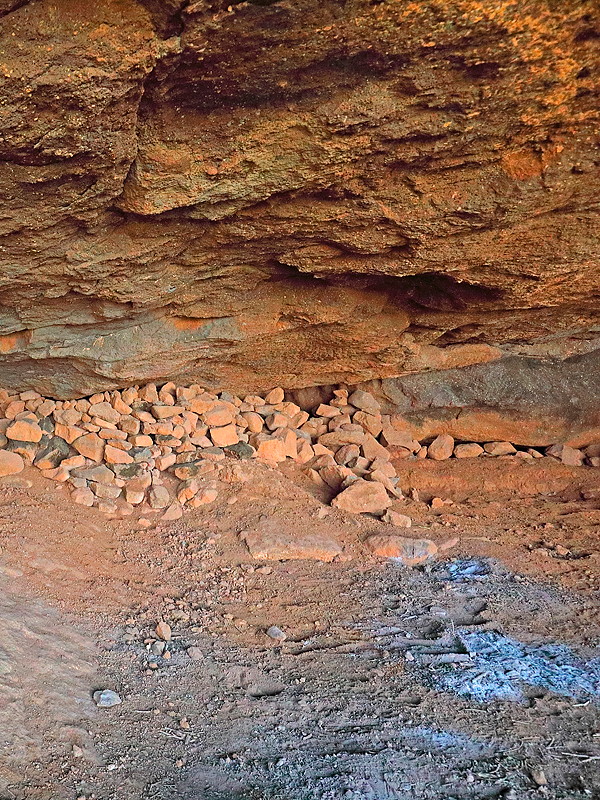 |
| |
| 29. Cavern, Shilatane cave, Maval Tehsil, Pune district, Maharashtra, India |
| |
|
|
| |
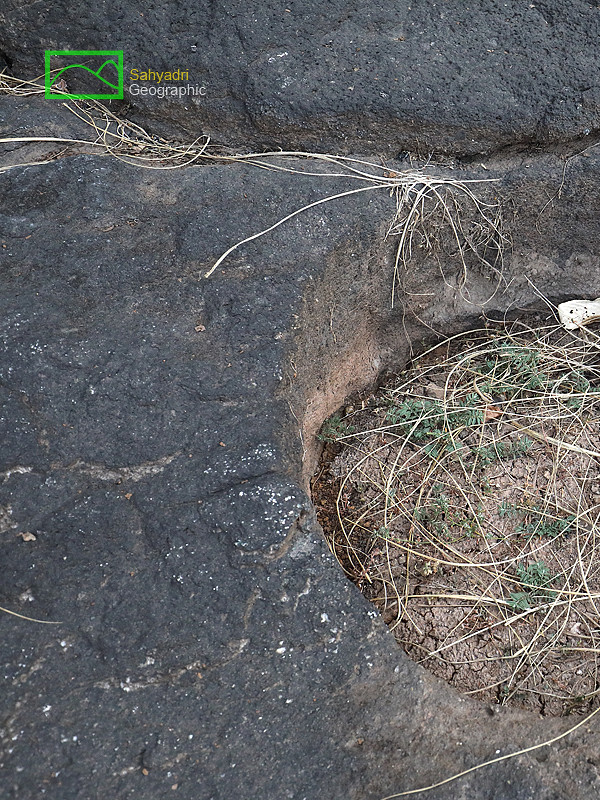 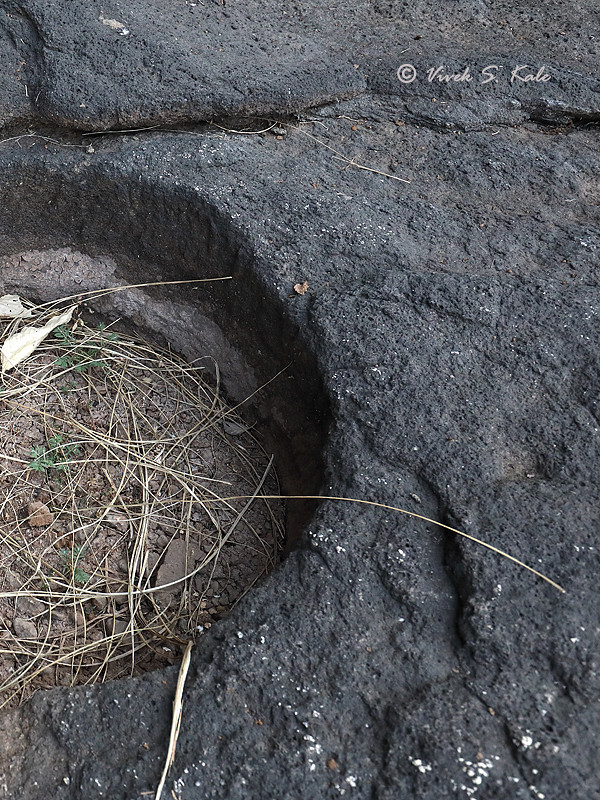 |
| |
| 30. Small Rock cut water cistern below water fall, Shilatane cave, Maval Tehsil, Pune district, Maharashtra, India |
| |
|
|
पाण्याचे टाके : धबधब्याखाली एक पाण्याचे लहान गोल तोंड असलेले मानवनिर्मित टाके आहे. हे टाके कपारीच्या बाहेर लगतच आहे. याचा व्यास ६७ सेंटीमीटर एवढाच आहे. यात माती भरलेली आहे त्यामुळे याची खोली किती हे समजत नाही. फर्ग्युसन ने मात्र त्याच्या लिखाणात या टाक्याचा उल्लेख केलेला नाही.
|
|
Water hole: The small water hole under waterhole was not mentioned by James Fergusson his records. It is located just outside the cavern, under the waterfall. It is about 67 cm in diameter at mouth.
|
|
|
| |
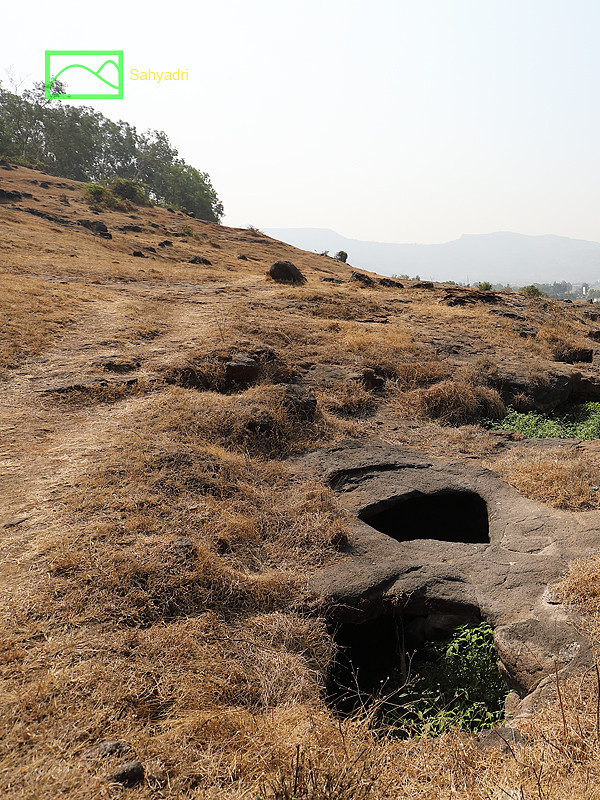 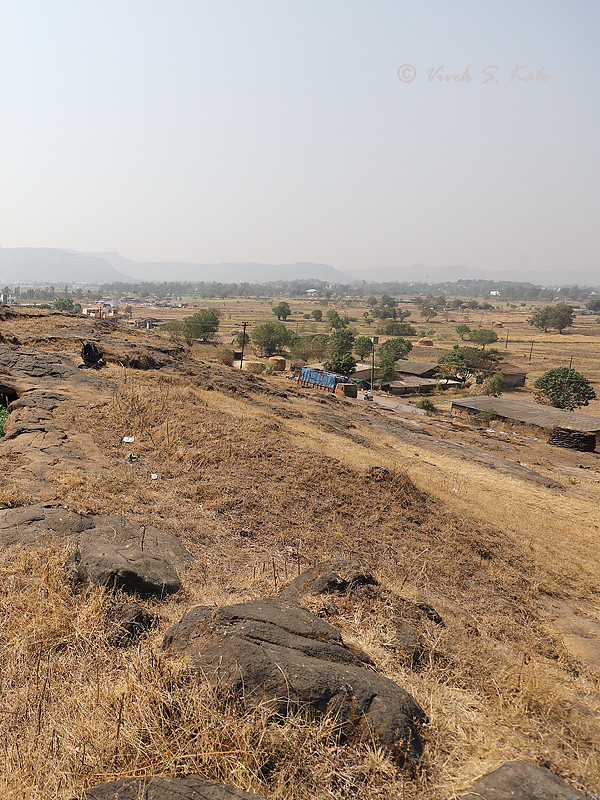 |
| |
| 31. Water cisterns at Shilatane Village, Maval Tehsil, Pune district, Maharashtra, India |
| |
|
|
शिलाटणे गावाच्या दक्षिण पुर्व दिशेला, डोंगर उतारावर दोन पाण्याची टाकी आहेत. या दोन टाक्यांपैकी एका टाक्याला २ झरोके आहेत, तर दुसऱ्या लगतच्या टाक्याला ४ झरोके आहेत. या टाक्यांचा उल्लेख जेम्स फर्ग्युसन आणि जेम्स बर्गेस यांच्या "केव्ह टेंपल्स ऑफ इंडिया" या १८८० साली प्रकाशित पुस्तकात आहे. या दोन्ही टाक्यात आज बराच गाळ आणि कचरा आहे. या टाक्यांचा शिलाटणे गावाजवळच्या लेण्यांशी संबंध असावा.
|
|
On south east end of Shilatane village little above the village level, on the hill slope, there are two underground water cisterns. One of the water cisterns has two irregular openings at top. The other water cistern has four irregular opendings at the top. These water cisterns are probabaly from the same era as that of the Shilatane cave. James Fergusson and James Burgess have described these water cisterns in Cave temples of India publication in 1880. Today the water cisterns are not in use and are half filled with rubble, and needs urgent attention.
|
|
|
| |
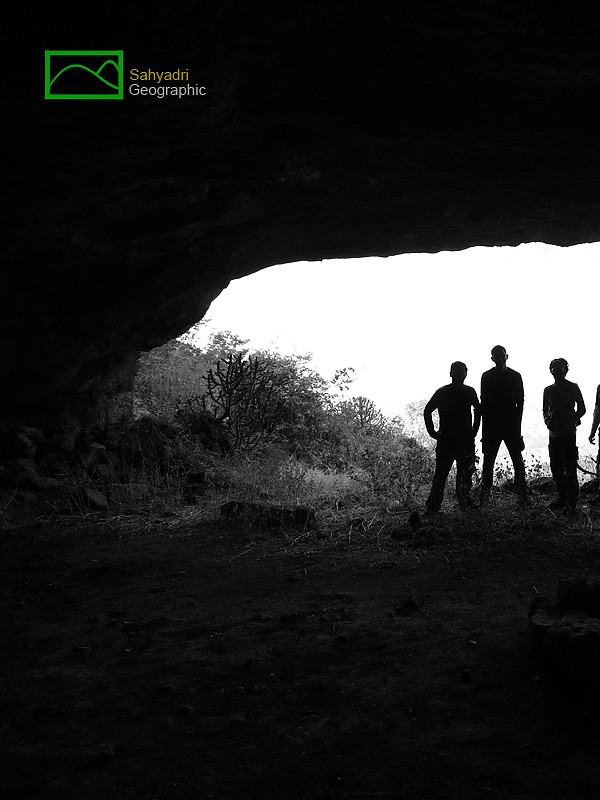  |
| |
| 32. Shilatane cave, Maval Tehsil, Pune district, Maharashtra, India |
| |
|
|
शिलाटणे लेणे : शिलाटणे लेणे पुरातन व्यापारी मार्गा जवळ आहे. हा पुरातन मार्ग कल्याण आणि सोपारा या बंदरांना दक्खन च्या पठारावरील अंतर्गत व्यापारी केंद्रांना जोडत होता. शिलाटणे लेणे कार्ले लेण्याच्याच डोंगरात आहे. मात्र या दोन लेण्यांना जोडणारी थेट पायवाट नाही. शिलाटणे हे एक अलिप्त लेणे आहे. पावसाळ्यात येथे जाणे अवघड आहे. मात्र पावसाळ्यात उपलब्ध असलेल्या पाण्यामुळे हे त्या काळात राहण्यासाठी योग्य वाटत असले तरी पावसाळ्यात येथे वहिवाट अवघड आहे. म्हणुनच कदाचित येथे धान्य साठवण्यासाठी मोठे टाके असावे. हे धान्य साठवण्याचे टाके इतरत्र पाणी साठवयाला वापरतात त्या टाक्यांपेक्षा वेगळे आहे. असे टाके येलघोळ या बौद्ध लेण्यात आहे. शिलाटणे लेण्याचे अजुन एक वैशिष्ट्य म्हणजे डावीकडे असलेले दंडगोलाकृती चैत्यगृह लेणे होय. याच प्रकारचे चैत्यगृह (रिकामे) इतरत्र भाजे, येलघोळ, वाळख, आणि खडकवाडी येथे आहे. अशा प्रकारची दंडगोलाकृती चैत्यगृह, सुरुवातीच्या लेण्यांत आढळतात. शिलाटणे लेणे गावापासुन १८० मीटर उंचीवर आहे. ही उंची इतर बेडसे, कार्ले, भाजे या १०० मीटर उंचीवर असलेल्या लेण्यांपेक्षा फारच जास्त आहे. यामुळे गावातुन रोज भिक्षा मागुन वर लेण्यात येणे थोडे गैरसोयीचे असावे. नैसर्गिक मोठी कपार लेणे बनवण्यासाठी वापरण्याचा प्रयत्न केलेला दिसतो. शिलाटणे लेणे सुरुवातीच्या काळात बनवलेले बौद्ध लेणे असावे.
|
|
Shilatane caves: It is very clear that the cavern is located close to the ancient trade route between Kalyan/Sopara ports and the interior of Deccan. The cavern is also close to the Karle cave complex. However there seems to be no direct trail between Karle cave and this secluded cavern over the hill. It is secluded hermit, used by the monks. As there is a large water stream at this cavern, it must have been ideal place in rainy season. However during the winter and summer, the water storage pot and water hole available here was probably used to store the water. The unique design of the rock cut container at Shilatane is almost exactly same as that at Yelghol cave. The cylindrical chamber (chaityagriha) is almost similar to that seen at other locations such as Bhaje, Walakh, Yelghol and Khadakwadi. The cylindrical chaityagriha is typically identified with early caves, with few exceptions. Also the altitude at which these caves are made is bit higher, 180 meter above village level, as compared to typical height of 100 meter seen elsewhere at Karle, Bedse, Bhaje and Patan. Such high inconvenient altitude from village suggests that this cave may have been created in early period. Also the use of natural cavern for making cave seems to be the early practice. Shilatane cave is most likely a Buddhist cave made in early time of cave making in this region.
|
|
|
| |
 |
| |
|
|
References :
1. Cave temples of India, London, 1880, Fergusson James and Burgess James.
2. Gazetters of Bombay Presidency, Poona District, Volume XVIII, 1885.
3. Buddhist architecture of western India, 1981, S. Nagraju.
|
| |
|
|
| |
|





































































